#Elvhen funerary lid
Text
Patterns and Styles: Elvhenan

The amount of elvhenan ruins in DAI and their details allow us to identify patterns that belonged to the elvhenan architecture. Many of these are clearly the inspiration from where Orlesian design took theirs.
This series of posts are not exhaustive since I’ve developed a very detailed list of tags tracking certain features of a given design. These posts merely try to gather in one place the symbols and elements I used most of the time when identifying buildings in my analysis of DAI.
[This post is part of the series “Patterns and Styles ”]
[Index page of Dragon Age Lore]
Patterns

Patterns are usually seen in the borders of the door frames or around the windows of an elvhenan building. Sometimes, these patterns decorate the walls of big keeps such as Suledin Keep. When we see these patterns in a building, we are immediately told that the origin of it was elvhenan, no matter what a contemporaneous, unreliable narrator may tell us via codices. Thanks to these details, we can know that codices such as Valeska’s Watch, which tries to explain the origin of the Valeska’s architecture as merely built by Grey Warden is not entirely true: the original structure IS elvhen, and we know this thanks to keeping an eye on patterns like these.
The main patterns I gathered are the following:


1 - It’s a patterns that looks like a small sun-like, but it could also look like an egg in flames [I wish I could know how to extract these elements from the game in an easy way, so I don’t have to deal with pixeled images]. The only important elvhenan object that comes to my mind related to this is the red dragon egg.

2 - I call this elvhenan pattern “flowers made out of circles”, and they are present even in very ancient elvhenan architectures such as the Solasan Temple. It’s a very typical patterns which may have inspired the thorny-flower-pattern of Orlais [right side]. If the Golden Ring is truly important in the Elvhenan culture, I may even say that this “flower” hides a “ring” in the centre of it.

3 - This one is a very subtle pattern that makes us remember a lot the way the Veil or magical barriers are paint in Murals in DAI: Basics. It’s also one of the basic patterns we see around Orlesian door frames, so I assume they took inspiration [or directly stole it, since it’s the same one] from this one.

4 – It’s a simple pattern of equidistant squares, which has some distant “flavour” to Dwarven style.

5 – Semi-circles are very commonly used too, usually presented in this exact way: two opposed rows of semi-circles.
6 – It’s the repetition of the pattern 1.
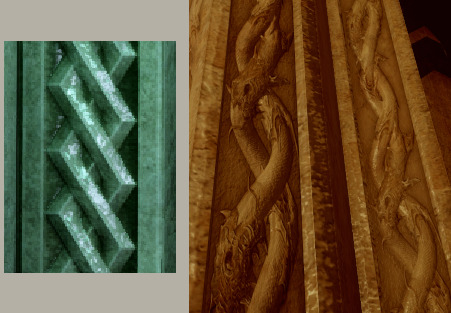
7 - It’s usually a vertical pattern that we see in columns or walls that extends from the ground up to the ceiling. Curiously, it’s a pattern that I can see it may have inspired the typical pattern we see in Tevinter walls/columns, where serpent-dragons eat each other as they twists upward. The elvenan one is a symmetrical version, usually presented in the main chambers of the elvhen temples. Sometimes, in the main chambers, this pattern is painted in golden.

8 - It’s an undulating line, usually seen in stair steps. We know how meaningful undulating lines are inside elvhenan art [details in Murals in DAI: Basics]. We can see this pattern decorating the main murals found in DAI too.

9 – Intertwined eluvian-like shapes. This pattern usually decorates handrails, and is present in main chambers.

10 - Another pattern usually seen at the basement of the elvhenan statues is this one, which emulates eluvians frames inside domes of similar shape. This pattern may have inspired another we can see in the Orlesian art, specially in the Winter Palace bell.
Architecture

The most distinctive detail about elvhenan architecture are its entrances frame and windows frames made in the shape of eluvians. The windows have a pattern of branches or “vines” upside-down inside them. This same pattern is seen in one of the mosaics of Fen’Harel’s mountain ruins, in the one where the chained figure is put upside-down.

Windows usually have three repetitions of the top of an eluvian’s shape, giving an impression of a gill. Windows and entrances are always decorated with the aforementioned elvhen patterns around their borders.


Important chambers in elvhenan buildings are painted in golden and green, and their ceiling have a resemblance to Gothic ribbed vault styles
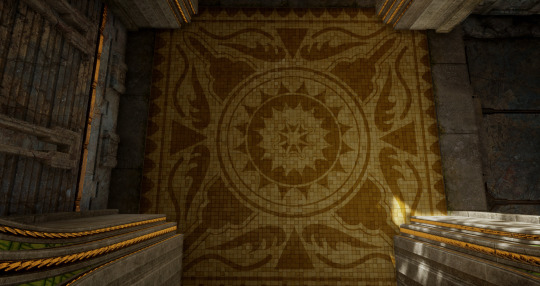
Mosaics are important in the elvhenan architecture. They usually decorate their walls or floors. The yellow-brownish mosaics that we usually find on the ground seems to be used to focus something important on its centre: the Asterisk Symbol, that could be understood as a proto-symbol of a sun but also we know that the elvhenan related it to a Titan’s heart, is usually used to place a statue/element of great importance on it. In the case of the petitioning chamber of the Temple of Mythal [ Temple of Mythal in detail], it’s the petitioner themselves who is placed in the centre of it. In places like Shattered Library, we find the red dragon egg on it, or the spirit of The Archivist. In temples like Temple of Mythal, we find the statue of Mythal in the middle of it, or a brazier in the chamber of Sylaise [which element is Fire]. In places like Cradle of Sulevin, each of the statues that keep a fragment of the legendary sword are placed on the asterisk symbol. In fact, if we see the whole configuration of the floor mosaic, it seems to suggest a Quincunx symbol.

Another kind of floor mosaic, sometimes seen on walls [as in The Lost Temple of Dirthamen] is the one that looks like a “flower” but I think it’s and oversimplification of the Quincunx symbol. We can even understand this one as an oversimplification of the previous detailed floor mosaic.
Decorations
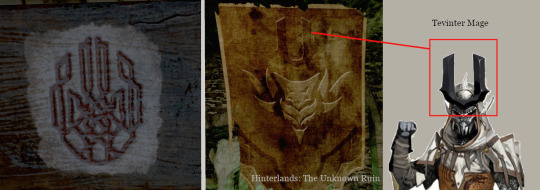
This is one of the most repetitive Elvhen symbols I saw, it’s usually found on boxes, but also on Elvhen funerary lid. There is a hint of a unique symbol in Hinterlands: The Unknown Ruin that seems to relate to this one, but so far, it’s a symbol that I barely could relate to a very styled, geometrical halla.
Due to its undeniable link to the helmet of a regular Tevinter mage soldier, I consider that there must be some connection with dragons too [otherwise, Tevinters would have no interest in it, so far we know]. This symbol also appears in several mysterious concept arts that give no hints to understand it. I hope DA:D will provide answers eventually.

In some places, such as Cradle of Sulevin, we find this decoration which has an important relevance in Elvhen history: thorny vines and sun-symbols appear in it giving the impression of being related to the codex Veilfire Runes in the Deep Roads but also to all those unreliable Dalish tales about Elgar’nan. Curiously, better versions of this symbol can be found in Fairel tomb’s dwarven seats. I’m not so sure if this asset can be considered irrelevant, since it’s used in Elvhenan temples, as well as backrests of dwarven chairs, but seems to have quite important elements of DAI lore to be totally overlooked.
This object is compounded of three elements that, depending on where you find it, some are on the background or the foreground. The main element are the thorny vines. In Cradle of Sulevin we find different versions of it while we trigger the Vir Tanahhal, the path that Andruil has “given” to the Dalish [some of these versions don’t have the upper figure that looks like a gem] while in others it is on it; the dwarven version keep it in the background.
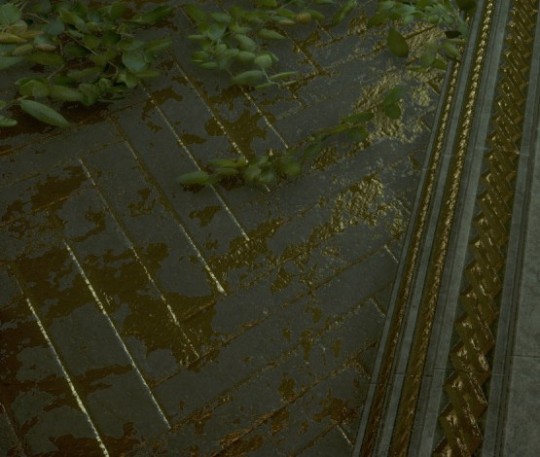
This pattern, usually only seen in walls of elvhenan temples, will be maintained by the Dalish in their clothes. Curiously, it’s also a common pattern in the clothes/armour of the Qunari.
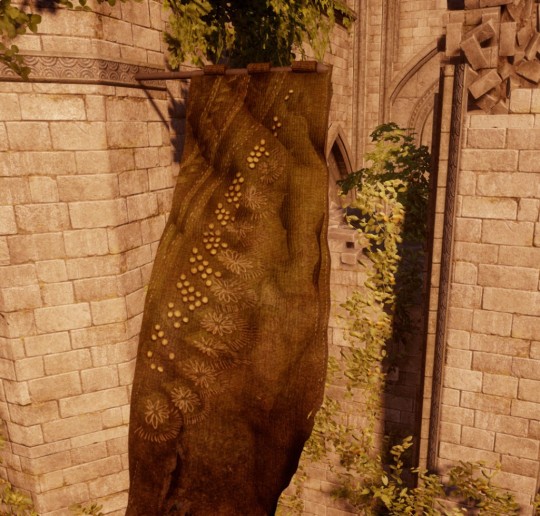
An important element that seems to be overlooked due to the distance is the Elvhenan flag: an asymmetrical brown flag/banner [maybe it’s just age that turned into this colour?] which displays dots and flowers.


Of course, there are a lot more of statues, fences, objects and decoration elements that should be considered, but I think I made a decent exhaustive tracking of them along the tags. There is also a good exploration of the paintings we find in most of the temples in Nation Art: Elvhen.
When it comes to statues or symbols, these targets can be checked:
Dragon Mythal statue
Humanoid Mythal statue
Howling Fen'Harel statue
Sitting Fen'Harel statue
Elven Owl statue
Elven hart statue
Elven Archers
Elven Tree Statue
Humanoid Dirthamen/Falon'Din
inuksuit
Red inuksuk
Golden Ring
Elvhen funerary lid
Evanuris Mosaics
Elven Orb
Vhenadahl
and potentially pointy tower
There are additional tags to explore such as Elven and Elvhenan design, although they are a bit more generic.
#Patterns and Styles#thorny roots#thorny vine#Elvhen funerary lid#quincunx#mosaics#elvhen design#elvhenan design
16 notes
·
View notes
Text
Arbor Wilds: Temple of Mythal - Part 3
Main Quest: What Pride Had Wrought
The Temple of Mythal was a place of justice, where petitioners walked religious rites of passage in order to have their pleas for justice heard by Mythal. According to some, it is also the site of some mysterious religious artefact called the vir'abelasan.

This post contains the following sections
Entrance to the Temple
The Rituals
Ancient Crypts: Red Templar's way
[This is part of the series “Playing DA like an archaeologist”]
[Index page of Dragon Age Lore]
Entrance to the Temple

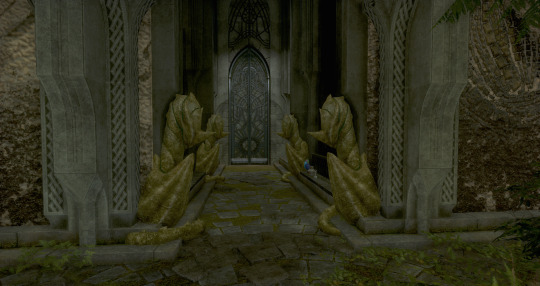
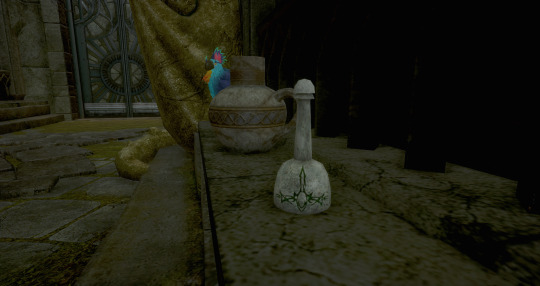
The entrance to the temple is enormous. Its door is waiting for activation via the rituals/puzzles. At its sides there are two gigantic, decayed mosaics of Mythal. In the small corridor of the door, there are four Dragon Myhtal statues. In the corridor, we find this curious vallaslin ink object that we had only seen it before in the The Lost Temple of Dirthamen.
The Rituals [Puzzles]
In this post, Diirthata-ma shows the name of the game files [I’m unable to have access to these by myself] which represent the puzzles. I thought it could potentially give us some hints about the statues used in them. So, the name of these ritual I use here were given by the game files.
Elgar'nan Ritual

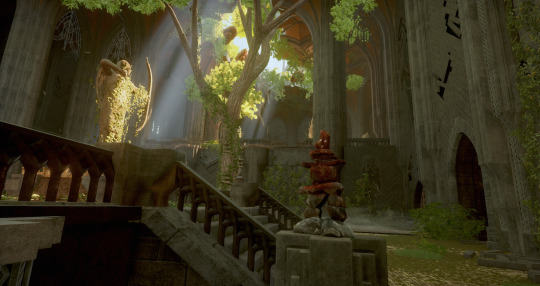
The first puzzle, the easiest and shortest one, is named Elgar'nan ritual. It's decorated with archer statues [that by now I suspect we can consider them as Shadow Sentinels], and on a rail of one of the stairs that lead to the puzzle, we find a small Red inuksuk. So far, I still keep the interpretation that these objects are related to sacrifice and blood.
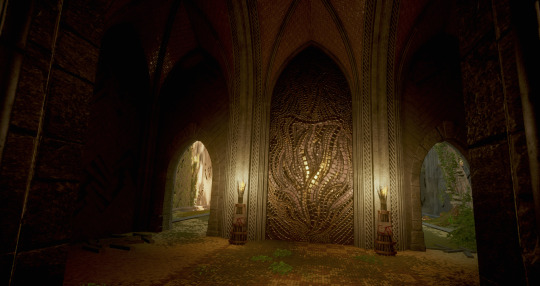
The entryway to this puzzle is decorated with a Sylaise's golden mosaic. I feel this is very fitting, since Elgar'nan is fury of great power [read the codices in the Temple of Mythal and in Vir Dirthara related to him] while Sylaise is as brutal as him considering the only non-Dalish codex we have: Song to Sylaise. Both figures are entities of fury, fire, and wrath in some degree. Sylaise seems to be a bit envious or competitive even.
Fen'Harel's ritual
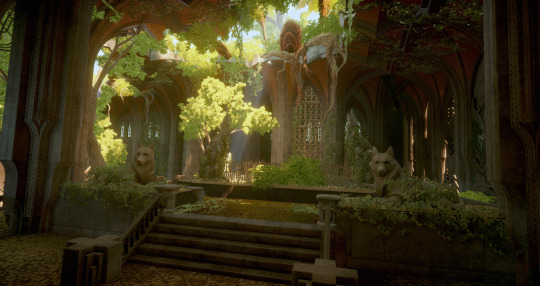
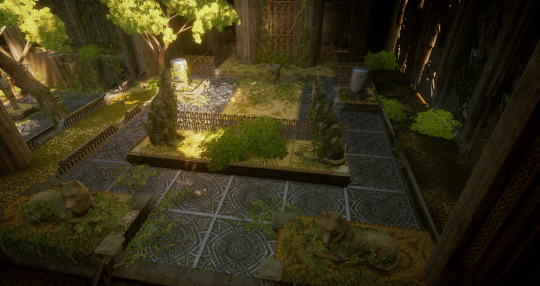

The second puzzle, with a lever, is Fen'Harel's ritual. It’s a puzzle with two potential interpretations: One, ironically, is that this puzzle needs you to be trapped in order to solve it [as a meaning to represent how he sealed the others gods, including himself (Cole says the wold chew his own leg to escape), to save the world], probably a poetic twist implemented by the Devs than something that the original Elvehan would have considered in the creation of this ritual. Another interpretation [more in-game and more “Evanuris”] is that this is the trickiest puzzle because the lever, and thus it represents Fen’Harel in the sense that you need cunning to solve it. [Unlike what wiki says, you don’t need to fail first to solve it. It has several different ways to be solved without failing it, it’s just a matter of tricks.]
To no one's surprise, it has several statues of Fen'Harel, in sitting and howling position.
Dirthamen's ritual
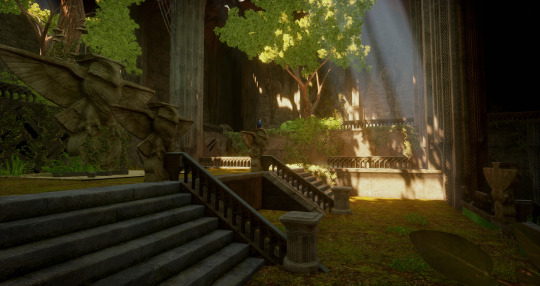
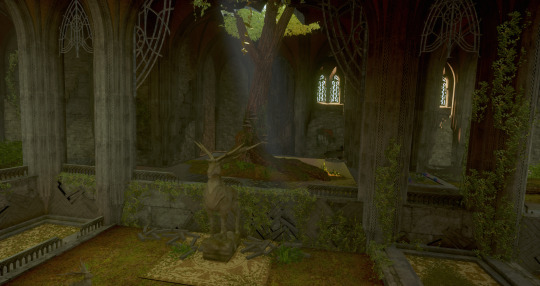

This is the longest one, which needs you to jump across different levels of the puzzle. It starts in the part of the chamber decorated with Elven Owl statues, and finishes in the one decorated with Elven hart statues. Due to the fact this is a puzzle that represents Dirthamen, gods of knowledge and secrets, it seems to present a duality [owl and hart] as usually Dirthamen/Falon’Din seem to exist in the iconography.
That the owl is present here, seems to have some reason: we have read in the game a codex saying that the owl could be considered the messenger animal of Dirthamen [as well of Andruil], but the hart seems to be a curious association. We know that the unreliable Dalish Tales relate hart figures with Ghilan’nain [for example, Ameridan did it in the DLC], and in the The Lost Temple of Dirthamen (Part 2), we find a red mosaic of Ghilan’nain [this association a bit more trustworthy]. In the codex Ancient Elven Writing [detailed and analysed in Ancient Elven codices, Temple of Mythal], there is a subtle relationship between Ghilan’nain and a servant of Dirthamen.
Therefore, Dirthamen and Ghilan’nain may have had some particular kind of relationship which is not clear to define with the information we have in game. It could have been an alliance or a rivalry of some kind. Honestly, considering Dirthamen’s dual existence with Falon’Din, I would have expected this puzzle to have more visuals of Falon’Din, as all things related to Dirthamen have and vice-versa.
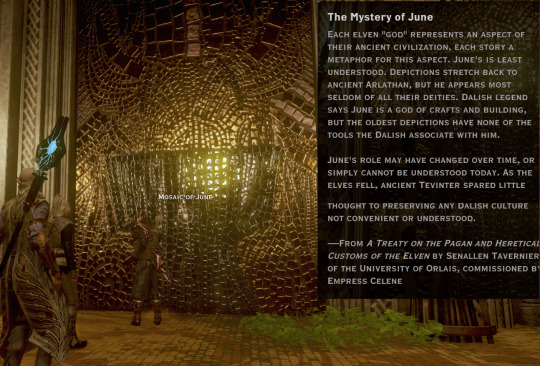
The entryway to Dirthamen’s puzzle is decorated with June's golden mosaic, which triggers the codex The Mystery of June, detailed and analysed in Ancient Elven codices, Temple of Mythal.
The only reason I can find to explain why two of these puzzles have entryways with mosaics of June and Sylaise, is because both of them have a portfolio of crafting in common. In the codices Vir Dirthara: Raising the Sonallium and in Song to Sylaise [detailed in Ancient Elven codices; Vir Dirthara and in Ancient Elven codices, Temple of Mythal] we can see that Sylaise is also dedicated to some aspect of the arts of crafting or related to architecture. Both of them may have been responsible of the construction of many of these buildings, in my opinion.

Once the puzzles are finished, the main door to the temple glows in blue and we are granted the access to the Petitioning Chamber.
Ancient Crypts: Red Templar's way

If we follow the hole on the ground left by the Red Templars, we have access to something that the game names “Ancient Crypts”. When we ask Morrigan’s opinion on this place, she says that it looks more like a fortress than a Temple.



The crypts present the most creepy murals from the post Nation Art: Elvhen

This place has decorations and structures similar to Dirthamen’s Temple or in general, similar to any elvhen crypt [like Dinan’Hanin]. As all elvhenan crypts, they are made with rough stones, and less decorated door frames and arcs.


The walls have these typical paintings. The only one I didn’t find is the Armoured figure from Nation Art: Elvhen. We even find these reptilian drawings in the Temple of Mythal. This repetition in so many elvhen places makes me consider this as part of a lore we don’t understand yet, and not just a Bioware joke about krogans.



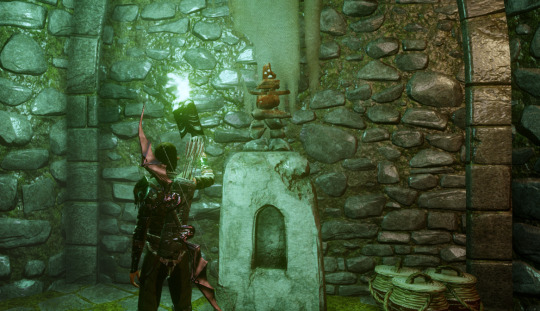
From dozen and dozen of screenshots we see most of the object we have seen in crypt-like scenarios like the Lost Temple of Dirthamen: different inuksuit, urns, Elvhen funerary lid, generic dead bodies, and some Red inuksuk [I kept this cute one, so small].

It’s in the crypts where we find Untranslatable Elven Writing which is Abelas’ confession about how he and his people at the temple endure their duty. Details in the post Ancient Elven codices, Temple of Mythal.

Ahead, we find another: Unreadable Elven Writing, which narrates about a unique and brutal weapon developed by Andruil, a golden spear. It’s not clear if this is like a codex that represents the main rival of Mythal. We can imagine that Andruil may have had a lot of resentment towards Mythal since they both fought and Mythal erased her memory of how to access to the Void [codex Elven God Andruil, detailed in Ancient Elven codices, Temple of Mythal].
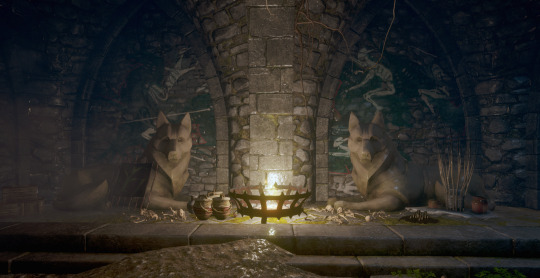
One of the many chambers of this crypt has a pair of Fen’Harel statues with the painting of the elves in battle. This makes me strengthen the idea that this mural painting represents a Rebellion more than a battle.


Next chamber, we find a broken Dragon Myhtal statue, with the painting of the dragon on the wall [which in several other situations seems to be a dragon that guides the painting of the elves ridding into battle] and in another section of the wall, we find the slaved elves, without face and heart. There are more snuksuit and more paintings of elves with vallaslin.


In one of the darkest chambers, we find an isolated statue of a hart.
Arbor Wilds: Temple of Myhtal - Part 1, Part 2, Part 3, Part 4, Part 5
#main quest#playing DA like an archaeologist#temple of mythal#Elven Archers#Elven Owl statue#Elven hart statue#red inuksuk#Inuksuit#Sitting Fen'Harel statue#Elvhen funerary lid#june#sylaise#andruil#Falon'Din#Dirthamen#Elgar'nan#elven pantheon#elven design#Howling Fen'Harel statue#Humanoid Mythal statue#dalish ink#vallaslin ink#elvhen mosaic#Evanuris Mosaics#Dragon Mythal statue
12 notes
·
View notes
Text
Arbor Wilds: Temple of Mythal in detail
The Temple of Mythal was a place of justice, where petitioners walked religious rites of passage in order to have their pleas for justice heard by Mythal. According to some, it is also the site of some mysterious religious artefact called the vir'abelasan.

This post is similar to Arbor Wilds: Temple of Mythal - Part 4, but it is not analysed within the context of the main quest. This is a more detailed exploration and analysis of the chambers.
[This is part of the series “Playing DA like an archaeologist”]
[Index page of Dragon Age Lore]
Petitioning Chamber
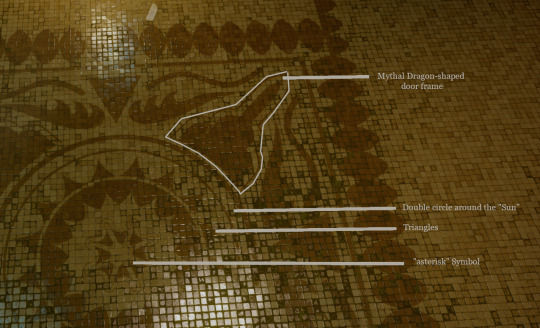
The ground mosaic in the petitioning chamber is the standard one used in most elvhen ruins. What I always highlight in it is the asterisk symbol that we have seen in elvhen murals to represent orbs or titan’s heart. It is inside a structure of circles and triangles that may suggest a sun inside a double circle. At the corner, we find a figure which outline looks like the shape of Dragon Mythal’s frame doors.
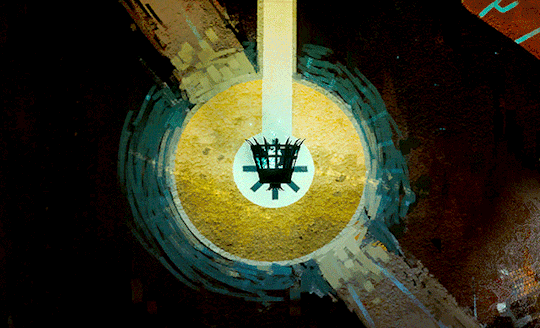
It’s very interesting that the brazier in most of the rooms of the temple are placed on the very centre of this mosaic, on the “asterisk” symbol. Similar detail happens in some elven murals, where the braziers of Veilfire are placed on the circles with the asterisk symbol on it. When there is no brazier or fire, the idea is to place a person on the asterisk symbol which gathers all the focus of the room, as it seems to work in the petitioning chamber or in the Fen’Harel rooms along the Temple.

The entrance of the chamber shows a disposition of statues and mosaics.
Mythal statues everywhere doesn’t seem odd considering this is her temple; she is the entity that will impart justice in this chamber [or her high priest]. What is curious are the details around the chamber:
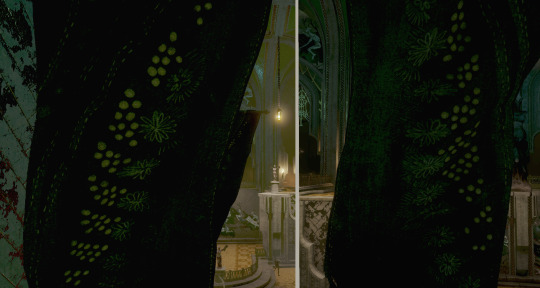
There are unique banners hanging from the sides of this chamber. I didn’t see them before in game. Probably this is related to Mythal or Elvhenan symbology. It’s a flower of many petals, and many many dots to a side. The other side of the flower seems to have just lines. Once more, Flowering Imago from Ancient Elven codices; Vir Dirthara comes to mind, the idea of several wills [dots] feeding flower.


At the sides of the platform where Abelas speaks there are two mosaics: Falon’Din’s and June’s.
This is very curious. They are not central, so it’s hard to see them when you have just stepped into this chamber, but they are more easy to see as you approach the main platform.
There are two small stages aside the main platform, with a long brown rug decorated with spherical trees. Each stage is closer to one of the mosaics. Imparting justice in this place may have had results that would lead to Falon’Din’s path or June’s. A path or judgement to Death (?), or one of… reuse? to be crafted anew? June is a mystery so far. We know he is related to the art of crafting in some ways, but we also know it’s not exactly in the ways Dalish think so.
On the other hand, giving followers to Falon’Din in judgements seems to be a terrible idea if we take into account what Solas told us in Part 2. But this temple may have been worked in this way before that event. Things may have been different until Falon’Din killed some of Mythal’s servants.
Each of these mosaics is beside a door. I think it seems reasonable to assume that those that were judged in a way or another, got a result that was associated with Falon’Din’s field [I suppose related to death] would leave the chamber through that door. In game, it’s blocked and goes nowhere if you cross it with fly-camera.
Now, the door beside June’s mosaic leads us to the Inner Sactum. Is this mosaic a representation of what June crafted in this Temple? Did June build the Vir’abelasan? Or this journey along Inner Sanctum grants a transformation of the persona that seems like a being “crafted” anew?
Remember that in the Courtyard, June and Sylase were in the entryways of the ritual-puzzles, giving the impression that this was a “sign” of their work, those mosaics were there to denote they were the ones responsible of crafting them. Maybe the same can be applied here. Even though it’s a bit more obscure since the opposite wall displays Falon’Din’s mosaic. All these questions and assumptions seem to be too much for my taste. There is so little we can use to infer with some degree of certainty.
The mural paintings of elves riding towards a battle can’t be overlooked [these murals are analysed a bit in Nation Art: Elvhen]. They are everywhere in this chamber and in the last part of the temple. It could represent the battle against the different Evanuris, probably using troops made of their own followers, but also it seems to be related to the battle for rebellion, since it has appeared in the ancient Crypts in a small chamber with sitting Fen’Harel statues. It could also be related to the battle against the Titans. It’s hard to know because the game has never ever gave us a lead to how understand that painting.

There are two ways to enter the Inner Sanctum: Forced [red line in the map] or Allowed [blue line in the map]. When we are allowed to enter, you have to follow an Elvhen Guide who grants you access to a unique chamber that, otherwise, you wouldn’t see [where most of the codices of the Temple of Mythal are placed]. The Guide opens secret doors and makes us avoid the combat against the red templars. Some rooms are separated just by a fence, which allows us to see what’s going on at the other side of the chamber. The Forced path is the one less rich in terms of details. It’s mostly rooms with minimal decoration and sentinel fighters.
Allowed Path [Blue]
Chamber M
The name of the rooms refer to the map of the beginning of this post.

The immediate chamber we are introduced, as we follow the Guide, is a small room with a golden statue and mosaic of Mythal. Here is where we can trigger the codex “The Judgment of Mythal” analysed in Ancient Elven codices, Temple of Mythal. [Note on the asterisk symbol of the ground mosaic: Mythal statue is placed on the asterisk. There is another asterisk without anything on it.]
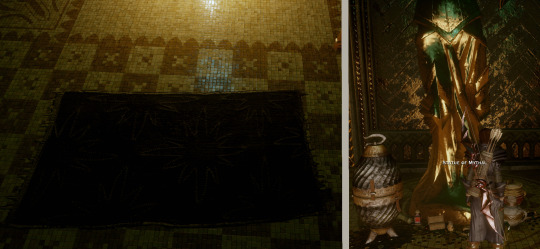
In front of the mosaic there is a rug with a pattern that looks like stars. I guess it may be used by the followers to sit and pray in front of her mosaic. The statue has the detail to be named “Statue of Mythal”, so there is no way we can question this.
Chamber D
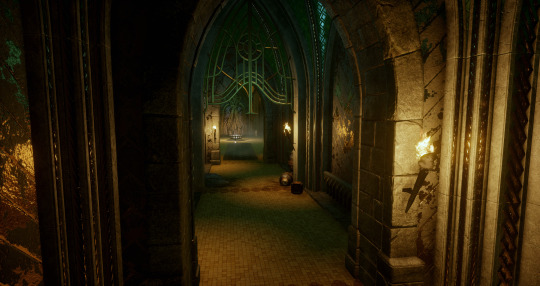
We continue towards the Chamber D using a corridor. From afar we see that at the end of the next room there is a Mosaic of Dirthamen.

We reach to a unique chamber that we can’t have access to if we antagonise Abelas.
Here, there are four mosaics that trigger some codices, and a rune, on a wall that the screenshot does not show, because it is opposite to Dirthamen’s mosaic. [Note on the asterisk symbol of the ground mosaic: there is a brazier on it]
The mosaics are Elgar’nan’s, which triggers “Song to Elgar'nan”; Ghilan’nain’s, which triggers “The Ascension of Ghilan'nain”; Dirthamen’s, which triggers the very suspicious and unreliable “Twins in Shadow” [I would love to hear a dev to tell us that this codex here is a mistake. What is this scholar doing here? Abelas and his sentinels would have never allowed a human to do anything to their gods’ mosaics. The author of this codex, a contemporaneous scholar, makes no sense to be found on this mosaic. This is painful to me]. Fen’Harel’s mosaic does not trigger anything.
The rune on the opposite wall triggers “Unreadable Elven Writing”. This same codex can be found in the Ancient Crypts if we skip the rituals to enter the Temple, but since we are following the path of the Guide, it’s obvious that we solved the rituals and didn’t explored the Crypts. This means that the devs considered this codex so important for the player that they made sure they would read it no matter what path you follow.
It’s curious that in Inner Sanctum, we cannot find any mosaic of Andruil. The only reference to her is this rune [there are also the owl statues that could be her messengers, or the hart statues, but both animals are not unequivocal representation of her]. This rune speaks about the construction of a weapon, a golden spear, which use will be catastrophic. [For more details, Ancient Elven codices, Temple of Mythal] I think there is more meaning for this to appear as a rune and not as a mosaic. The lack of an explicit mosaic of Andruil seems to speak of an enmity with Mythal. At the same time, a veilfire rune, which preserves memories and information much better than a mosaic which can fall apart over time, may imply that the people writing this wanted the message to exist even despite the worse conditions. However, Andruil has a place in Mythal’s temple: outside, in the ritual garden, inside a room that looked like a golden cage. One for her, another for Falon’Din [maybe the most problematic Evanuris for Mythal?].
Each of the mosaics have a rug in front of them. Since this chamber follows the room M, focused only on Mythal, and it’s protected by the activation of the secret paths by the Guide, one could suspect this is a room where Mythal’s allies are represented.
Fen’Harel has always been a good friend of Mythal. There are many proofs from Solas, defending her memory, but the most important one for me is Flemeth in the last seconds of the game, calling him Old Friend. Fen’Harel has always been her friend, and Fen’Harel has always respected Mythal, considering her the best of all the Evanuris.
Elgar’nan may not have been a friend, but his trust in her is undeniable. He gave Mythal the ability to impart justice so his fury would not go out of control for every argument [codex: The Judgment of Mythal]. He also trusted her wisdom when Falon’Din tried to start a war against him [codex: Duel of a Hundred Years].
There is no information about the relationship between Mythal and Ghilan’nain, but given the fact that there are two mosaics of allies in this room one can suspect that she belongs to allies too. Or at least, she was an ally in the beginning.
We know there is a relationship between Dirthamen and Ghilan’nain [Red mosaic of Ghilan’nain in The Lost Temple of Dirthamen, and her involvement in suggesting one of the servants of Dirthamen to take Divine shape, codex: Ancient Elven Writing in the Ancient Crypts of Temple of Mythal ] that may have been extended to Mythal, whoever of them had a deeper link with her.
I suppose Dirthamen had a relationship with Mythal since in Flemeth’s Fade we see a statue that the game has unreliably suggested to represent Dirthamen, stabbed and bleeding. But due to his duality nature with Falon’Din, it could be him, being bled as Solas told us that Mythal had to do with the rest of the Evanuris to stop Falon’Din. It’s always a problem to understand anything with those two involved.
I suppose that the Veilfire rune present in this room, in this particular context, can be interpreted as a Warning for the supposed allies of Mythal. After all, the rune speaks of a terrible weapon made by Andruil.
F’H Room

[Note on the asterisk symbol of the ground mosaic: there is a brazier on it]

The next room has two sitting Fen’Harel statues and a rug in between. It’s not clear if this is a place to pray for him since the rug is in front of a wall without a mosaic [of we follow the pattern in most rooms], but it could also be prayed at the statues, I guess. There are some broken funerary lids in the southern corner of this room.
Sy Room
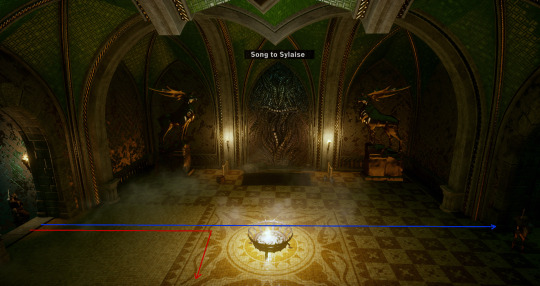
Next room is Sylaise’s. [Note on the asterisk symbol of the ground mosaic: there is a brazier on it].
She has one full room for her in Mythal’s Temple. This is very curious to me. There is a mosaic of her that triggers the “Song to Sylaise”, which is the only real codex we have about her non-based on Dalish legends. In front of it there is a rug to pray in front of her, and two elven hart statues, which are rare objects to find here. We know little about the true Sylaise [the one which is not based on Dalish Tales], and so far I know, we connect the hart symbol with Andruil or Ghilan’nain. That these harts are positioned as guardians around her mosaic, may have similar meaning to those located around Dirthamen’s mosaic? Is the Hart a shared favoured animal between Sylaise and Andruil? Or this is a symbol to show that Andruil and Sylaise were allies? If that were case, would Mythal allow a single room for praying to her? Tons of questions, none answer.
Corridor with Archers
The Allowed path lets us explore a broad over-flood corridor. There are no mosaics here, but only two archers that point nothing. Similar configuration was found in The Lost Temple of Dirthamen - Part 2, in the Path of Secrets.

I’m not sure if this could be understood as something related to Andruil or The People. There is no much to conclude here.
Room 3
This is the room where both path, Forced [red] and Allowed [blue], gather once more.
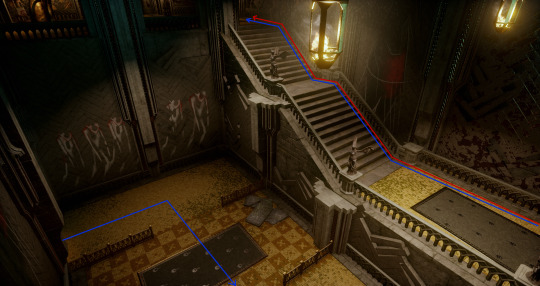
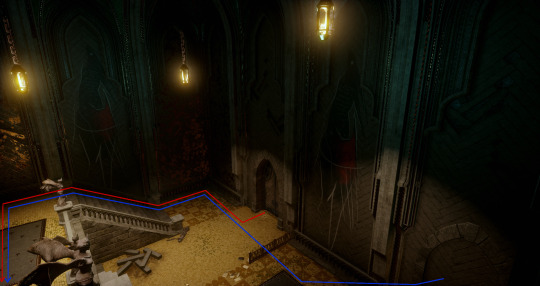

From the corridor with Archers, we open a sealed door and have access to this room where we see a stair with a painting of the black dragon [Nation Art: Elvhen] on the walls heading up, inviting the walker to go upstairs. I suppose this will imply a meaning of ascension [we are getting close to the Vir’abelasan], while on the ground level’s wall we see the “zombie” elves.
The stair rails are decorate with many small Mythal statues. There are no imposing statues of her outside the petitioning chamber and the M room. And even in those rooms the statues are rather medium.
F’H Golden Halla
At the top of the stairs we find what I called “F’H Golden Halla”
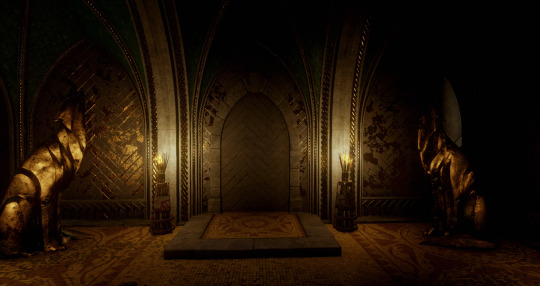
[Note on the asterisk symbol of the ground mosaic: the place is free for the person who would contemplate the hidden room could stand on it.]
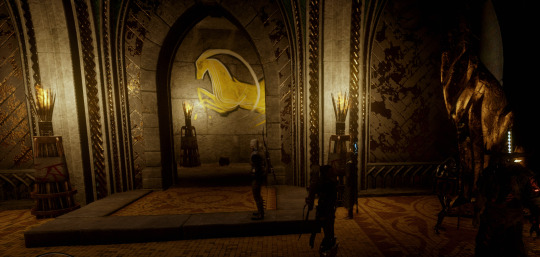
Howling Fen’Harel statues guard a secret room where there is only a golden halla painting [Nation Art: Elvhen] and some minor loot. This small room can’t be seen by those who forced their entrance, since it’s our Guide who opens it. It seems to be a secret messenger to those who are friend to Mythal.
Or maybe this whole configuration means that Fen’Harel [Howling wolf] is guarding “the people” [represented in the Golden Halla, a Halla that is valuable because it’s golden like all the golden statues and mosaics in the temple that only represent Evanuris].
It could also mean a small tribute to Fen’Harel’s work: if the halla represents The People, Fen’Harel statues at the sides of what looks like a small, humble chapel would suggest that the real entity that should be worshipped is The People? So many holes in the many, many elvhen symbols we have in the game.
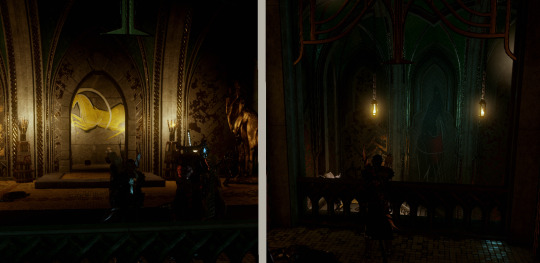
The Halla faces, bellow and across the room, directly to the ascending dragon. Both images are very well framed in the configuration of the room. Not sure if it means anything, but it’s a detail that stands out if you spin in this place.
Rooms 4
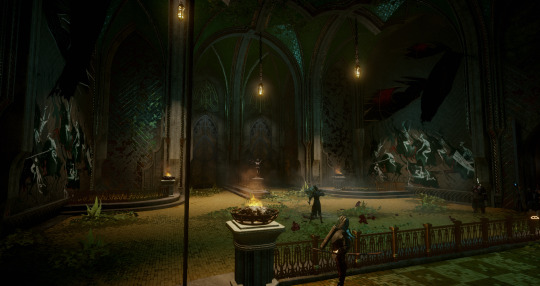


In this part, we see the last fighters of the elvhen, killing Red Templars. There are more mural paintings of the battle elves and the dragon from the room 3. If we see the connotation, it is as if this dragon were guiding the zombie elves from the previous room, at the ground level, into battle: now they became these elves that fight guided by the dragon. It’s hard to know when these murals were done, if they were always part of the Temple since the construction of it or were decorations made after, during the last times of the Evanuris. If we could know this, it would allow us to develop many different interpretations.
By walking past a small figure of Mythal, we leave the room heading into the garden where we find the Vir’abelasan.
Once more, Mythal appears in non-imposing sizes. She is always small, decorative, while what’s truly imposing and overwhelming is the mural of the battle.
Forced Path [Red]
The only two rooms we don’t see if we go through the Allowed path are Mu Room and Room 2
Mu Room


The only particularity that this room has is that it has four mural paintings: two standing elves on a side and two in fighting position with a shield, on the opposite wall.
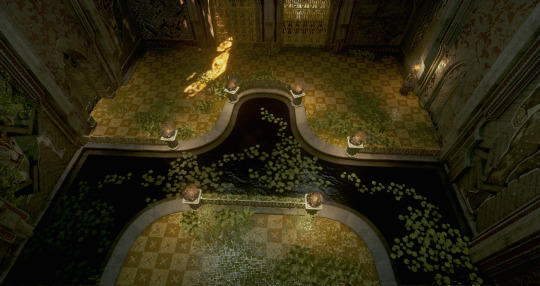
It also has a small decorative pool.

From here we can see the superior rooms: Room 2 and 4.

One would suspect these murals are as old as the temple, and were intended to be part of it, simply because the walls where they are painted on are not “old golden”. It seems to be meant that these drawings would be part of these walls from the construction of the temple. They do not look like “graffiti”.
Room 2
This room has nothing to add. It has a squared pool too, less pretty than the one below.


These three rooms [Mu Room, Room 2, and 4], can be seen at the same time since they are placed in the same space but at different levels. [Note on the asterisk symbol of the ground mosaic: none of these rooms have this ground mosaic.]
#temple of mythal#andruil#Falon'Din#Dirthamen#mythal#fen'harel#Ghilan’nain#Elgar'nan#Evanuris Mosaics#High speculation#Humanoid Mythal statue#Elven Owl statue#Elven Archers#Elven hart statue#elvhen design#elvhenan design#elven pantheon#Elvhen funerary lid#golden halla#elven design#Howling Fen'Harel statue#Sitting Fen'Harel statue#Playing DA like an archaeologist
15 notes
·
View notes
Text
The Lost Temple of Dirthamen - Part 2

The Lost Temple of Dirthamen is an ancient temple dedicated to the elven god Dirthamen. It is located in the northeastern Orlais, off the northern coast of the Waking Sea. Along the years many treasure hunters went after the wealth inside it, but they never returned.
[This is part of the series “Playing DA like an archaeologist”]
Sanctuary

The Sanctuary is a big chamber of the similar dimensions than the petitioning chamber in the Temple of Mythal.
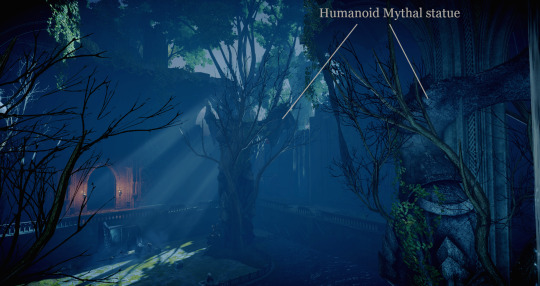

When we enter we see four Humanoid Mythal statue in the centre. The walls at the sides of the entrance display different enigmatic details: a winged, insectoid halla; an elvhen warrior, a lizardman, and two mosaics: a dual mosaic of Falon'Din in a usual green colour, and Ghilan'nain's mosaic in RED.
The Sanctuary is made of two levels, as most elven temples are: on the lower level there is a pool with elven owl statues, where several altars are arranged in a semi circle. The first floor is collapsed and falling apart, impossible to access to.
Let's see each of these walls and the information they contain:
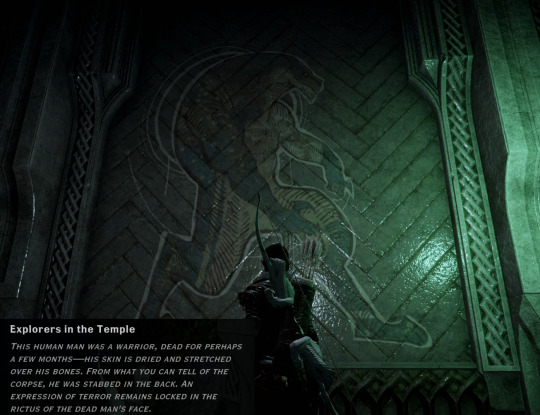
The lizard man painting shows the note of the dead mercenary that I already spoke about.


The wall beside the lizard displays a red mosaic. This mosaic was such a pain in the neck for me. I could not see it in my game due to the darkness of this Temple, and the screenshots were also too dark. Until I realised the reason of its darkness was because the colour itself: unlike the other mosaics which appear in light green, this one is dark red. I had to take a screenshot blindly and then break its saturation and brightness to make it visible at least. That's the reason of the bad quality image above. On the second image, I overlapped the Ghilan’nain's mosaic, to be sure there were no alterations hidden with the darkness. And as it can be seen, there are none, the only odd thing is that the mosaic is too cut off to frame properly the halla.
Behind this mosaic we find the Path of Secrets, where we find another painting of a lizardman marked by an elven owl statue. The implications that Ghilan’nain is hiding a secret of arcane nature, keeps bringing a lot of connections with The Horror of Hormak.
Along the temple we collect pieces of the codex The Lost Temple of Dirthamen, which explains how a small group of disciples of Dirthamen were informed by their High Priest that Dirthamen was gone. They fear their secrets can be extracted from them, so they despair. Their High Priest tries to comfort them, telling them they are safe as well as their secrets, but they [as disciples of the arts of secrets] can see his deception: apparently, the High Priest wants to perform a ritual using the blood of the disciples to trap them all in this temple [it's our blood he seeks, a sacrifice dark and unholy, a prison of evil to keep us in and all else out]. The next stanza seems to mean that the ritual was meant to remove the secrets that the disciples knew, but they rebelled, performing a counter-ritual in which they dismembered their High Priest and bounded him with them into the dark silence of this temple.
What I like to highlight here is that there is a repetition of the bounding process all over the game DAI:
It's quite clear that the High Priest and disciples of Dirthamen have a deep knowledge in bounding rituals. They seem to be made out of blood magic as well.
In the context of DAI, we are presented with another bounding process: the one that the Grey Warden perform via blood magic to raise an army of demons. This knowledge was shared by Corypheus.
That Corypheus knew about it means that he potentially learnt it from elven magic [as we know a lot of Tevinter magical knowledge ended up being a co-opt from elvhen knowledge when the empire was falling apart]
Recently, in Tevinter Nights: The Horror of Hormak, we have access to information that allows us to speculate that Ghilan’nain was responsible for the magic that transformed creatures into chimeras and bounded creatures with different souls to one body. Therefore, her mosaic in this Temple could potential imply that she also knew the secret of some powerful magic related to a bounding process.
All this means that, potentially, the elvhenan may have always known means to bound people, spirits, and bodies.
So, with all these bits of information and speculations, I like to interpret that, this temple, showing us a dual mosaic of Falon'Din at the entrance of the main chamber where "Dirthamen's wisdom" is hidden could potentially mean that Falon'Din bounded Dirthamen to his own will. This would explain why Dirthamen's favoured animals are blurred with Falon'Din's and why their tales always blend one another.
Sadly we don't know when this event in the Lost Temple of Dirthamen happened. We know this tragedy was triggered by the disappearance of Dirthamen, which is not clear if it was caused by Solas with the creation of the Veil or before that time. If that were the case, it could also justify the hypothesis that Dirthamen had been bounded to Falon'Din's will long time ago. Why would Falon'Din do that to Dirthamen? Solas told us that Falon'Din’s vanity was enormous, and it was implied that he would take any measure to increase the amount of worshippers [even to challenge Elgar’nan, according to old codices], so maybe acquiring the secrets of Dirthamen could have helped him in that endeavour. However, all this falls in the field of speculation.
Rooms accessible from Sanctuary
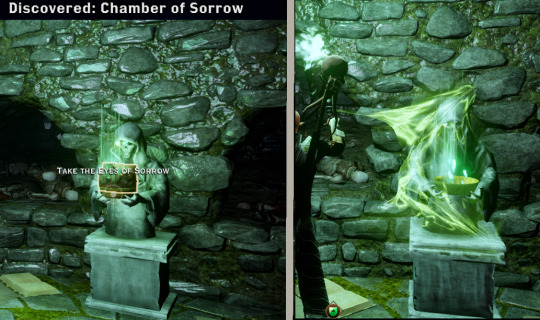
Through the Sanctuary we have access to more chambers where we keep collecting the pieces of the High Priest of Dirthamen. Each time we take a piece, we see a Fade-rift effect.
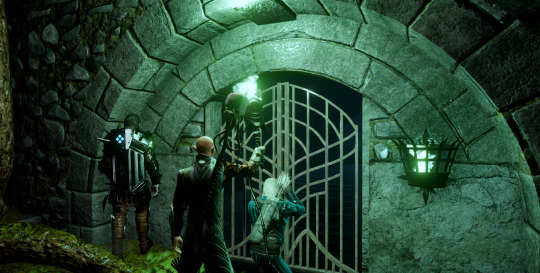
In these extra rooms and corridors, we have access to more chambers that have little difference to all what we have been seeing so far: all funerary, crypt-like chambers behind locked gates.
There are only 2 rooms that have some interesting content, one beside the other:

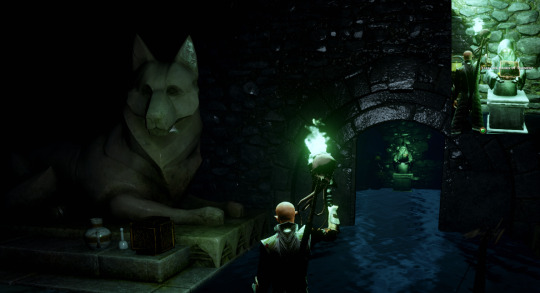
One of these rooms, called the chamber of torment, is guarded by two sitting Fen’Harel. At their base they have books, an elvhen box, and these white objects with a wing-shaped symbol on it that are presumed to be Vallaslin ink.
The other room is marked with the elven owl statue, where we find the Path of Secrets.
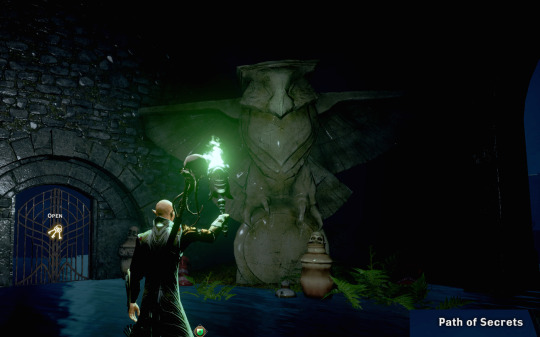
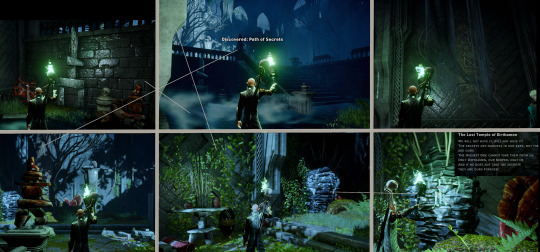
This path is behind the red mosaic: the path of secrets. It’s marked with an elven owl statue. The wall at our right displays the painting of a lizardman. In front of it, there are inuksuit, including the Red inuksuk. We also see ragged Dalish hide and urns.
If we climb up the stairs, we find another Red inuksuk on the handrail, the Archer statue, and more inuksuit that keep updating the codex of the Lost Temple of Dirthamen. Usually the Archers keep pointing out a place where to go, but in this case they only mark a veilfire brazier.
Complete the Ritual

Once all the parts of the body are collected we can go to the Sanctuary and place them on the altars.

When we approach the main desk in this ritual configuration, we notice that the desk is made of a dark metal, and has a picture of a pointy tower. Both elements look more like Tevinter style than Elvhen.
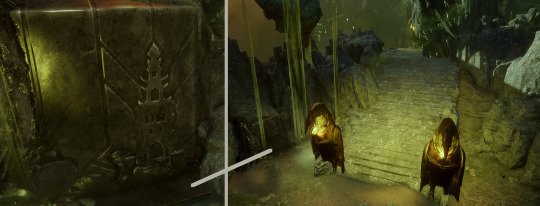
The same object can be found in the Fade, at the sides of the eagles which gives us access to a place with many claws of Dumat and Tevinter objects [For more detail, see the post related to Fade].
Finally, here we have the last part of Explorers in the Temple (stained notes). It explains that the mercenaries saw Gretien running away from the Temple at night. They assumed it was because the nightmares caused by the “voices”. The same ones he used to dismiss, according to previous notes. Not wanting to waste months of works, the mercenaries attempt to finish the ritual and get money from the treasures in this place. As the codex continues: these mercenaries deciphered Lord Gretien's notes and performed the ritual without him. They also comment that the scholar reached to the conclusion that this ritual was a way to "reassemble" the High Priest. This mercenary clearly is not a specialist in Elven culture, we can agree on that, yet he finds it unsettling that the elves would dismember their own priest. We are seeing a side of ancient elven culture that, curiously, looks like very Tevinter.
Since these notes have dried blood, it is clearly that they performed the ritual, summoned the demons, and got wounded. By the body found beside the entrance to the Sanctuary, we can be sure that most of them perished or escaped to never come back.


Once the ritual is completed, we see a rift appear, summoning the Highest One, who is now a despair demon. I assume the rest of the demons that come with him are the disciples. They mutually bounded themselves to this Temple.

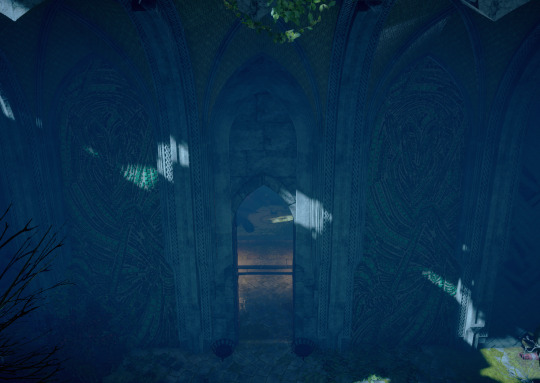
Anyway, once we kill the demons, we have access to the main chamber of this place [the main door is decorated with two Falon'Din's mosaics].




This room shows the elements of an Elvhen Temple that I was expecting: golden elvhen patterns on the door frames and walls, beige mosaics, gigantic imposing golden statues, in this case of a pair of Howling Fen'Harel [I had to modify the brightness of some images to make them a little more visible at the expense of making them look uglier]. There are more inuksuit around [which makes sense if we think in what Solas told us about Falon'Din: He would massacre a lot of people in wars to increase his worshippers out of vanity, so his Temple may look more like crypts. At this point I keep wondering why this temple is called "of Dirthamen". Nothing here makes reference to him, but everything seems related to Falon’Din.

These statues are made of gold. It's strange that the main chamber of the Temple of Dirthamen [or Falon'Din] has central figures of wolves. Would that mean that there are more wolves in the elvhen pantheon than Fen'Harel?
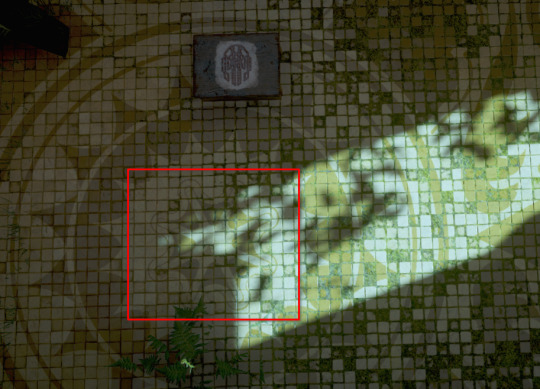

Where the loot lays there is a bigger mosaic on the floor, displaying a sun, surrounded by circles and its centre has a similar asterik-shape to that one found in the Mural of the titans. As if this were the representation of an elven-orb or a titan's heart.
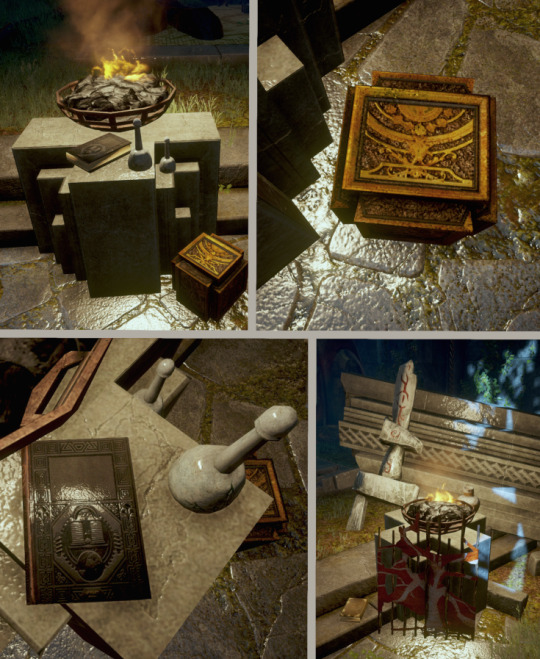
In a corner we find a book with a cover I don't think has much of interest. We find an elvhen box and that strange white item that apparently it's ink, according to the game files. We also find some Dalish elements [the fence made of hide] that may have belonged to some ancient Dalish explorers.

The loot is a shield called Dirthamen's Wisdom, what the scholar Gretien was looking for. It has a very Tevinter style, and its description says that the power contained in this shield is so great that prevented the item and the temple from falling apart due to decay. This implies that the Temple will fall soon after we remove this item from here.

The loot is a box with a symbol we had seen in the elven funerary lid.
The Lost Temple of Dirthamen: Part 1 - Part 2
[Index page of Dragon Age Lore ]
#elvhen design#elven design#inuksuit#paintings#red mosaic#Ghilan’nain#Humanoid Mythal statue#Sitting Fen'Harel statue#falon’din#Dalish ink#Red inuksuk#Elven Owl statue#Tevinter objects#glyphs#Elvhen funerary lid#asterisk symbol#Playing DA like an archaeologist#pointy tower
10 notes
·
View notes
Text
The Lost Temple of Dirthamen - Part 1

The Lost Temple of Dirthamen is an ancient temple dedicated to the elven god Dirthamen. It is located in the northeastern Orlais, off the northern coast of the Waking Sea. Along the years many treasure hunters went after the wealth inside it, but they never returned.
[This is part of the series “Playing DA like an archaeologist”]
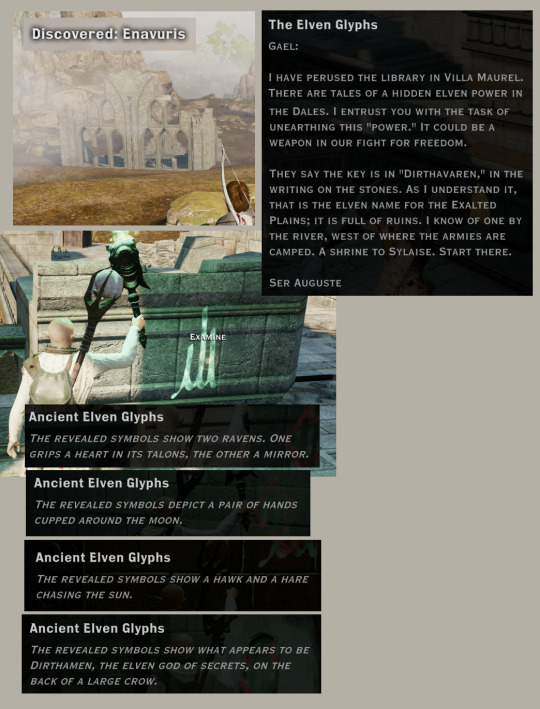
This Temple is found in an elaborated way. We starts in Exalted Plains, collecting several elven glyphs. Each of them, I assume, could be related to a “secret”. One can only speculate about them [As a note, I’m trying to follow only the information we got from the oldest and more reliable sources: codices and inscriptions from the Temple of Mythal and Shattered Library.]:
Two raven. One grips a heart in its talons, the other a mirror: Is the secret of the construction of Eluvians associating it with the heart of a titan that the elves stole? We know via murals that titan’s hearts are sources of power.
A pair of hands cupped around the moon: the only moon-like imagery we have coming from the elves is the orb. [Yes, Dalish relate Mythal with Moon, but Dalish barely get anything right, so I prefer to avoid them as much as possible]
A hawk and a hare chasing the sun: So far we know from the unreliable Dalish tales, both animals are related to Andruil, who is called sometimes mother of hares. The hawk could be a wrongly interpreted owl, which is an animal messenger of Andruil or Dirthamen. Dirthamen is also related to other two birds: ravens and crows. In any case, the sun is a strange symbol. The sun appears in the Shattered Library on the top of some eluvians. The elven mosaics show a circle at the background in the case of Mythal and Fen’Harel that could be interpreted as a sun. Sylaise is related to extreme fire. If we incorporate the Dalish tales, we know that the “original father of the gods/Elgar’nan” is the Sun. So this could mean that Andruil chased after an ancient god / powerful entity?
Dirthamen on the back of a large crow: it may be the only hint we have to relate crows to this god. Or maybe the crow is related to Falon’din? With these twin gods you never know.
Investigating these glyphs in the war table, we are informed that these runes are older than the places we found them, meaning that they are not Dalish but Elvhenan. The place they point out is located far north-east of Orlais, and it is considered already spoiled since it’s not the first time someone got interest in these glyphs. Treasure hunters headed to the temple years ago, but they never returned. Recently, an archivist called Gretien got his interest in it and went into an expedition.
Entrance
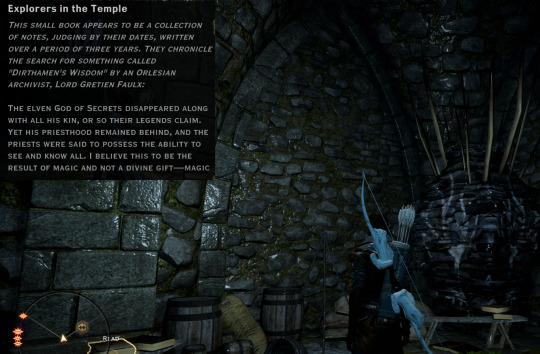
When we find the temple, the first things we find are objects of explorers close to the entrance: tents, unrelated books [like Hard in Hightown] and encampment supplies. Here Explorers in the Temple (collection of notes) triggers. It narrates that an Orlesian archivist, Lord Gretien Faulk, started this expedition to find the power to see and know all. He is convinced that this power is not a divine gift but magic, and it can be attached to treasures, hence his search for the "Dirthamen's wisdom".
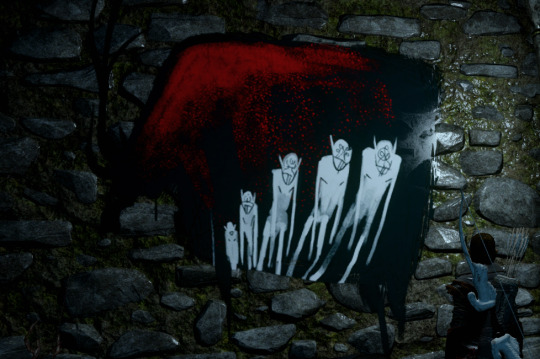
Immediately next to the entrance we find one of these elven paintings on the wall, showing a halla with elves wearing vallaslin.
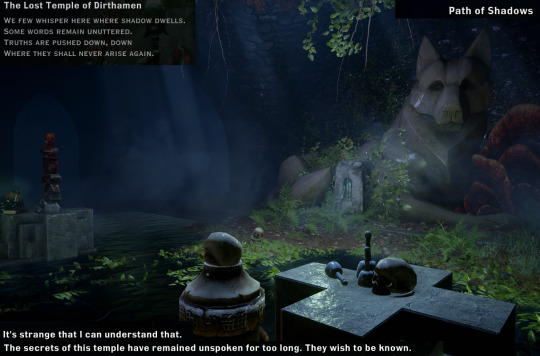
Few steps ahead along the corridor, we meet a statue of Fen'Harel, as usual. Analogous statue was found at the entrance of the Temple of Mythal. A glyph can be seen which will trigger the first part of a Codex that will be updating along the exploration: The Lost Temple of Dirthamen. There are also many funerary elements around such as urns, Red inuksuk, and a strange object that we saw in the Temple of Mythal as well: a white bell-shaped object that, via game archives we know it's ink. There is a chance it could be related to the Dalish ink for Vallaslins.
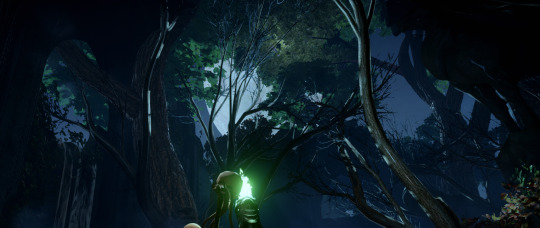
Following the corridor, we see moonlight illuminating part of the path: a portion of the ceiling has collapsed. This corridor will guide us to one of the chambers where we collect the pieces of the High Priest.
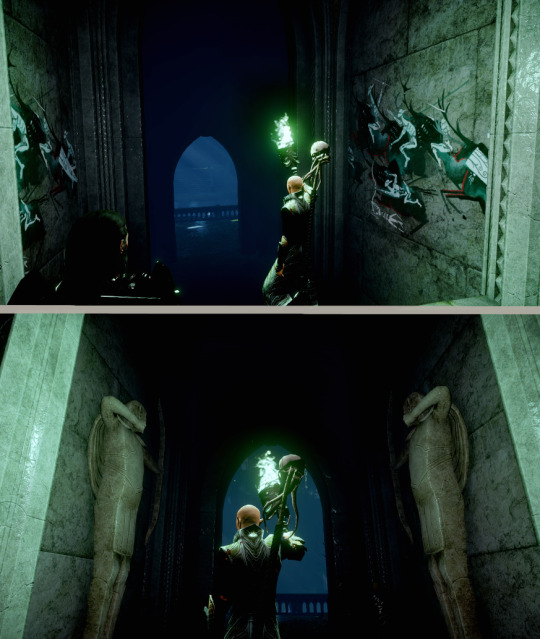

If we stay in the corridor, there is a bifurcation marked with Archer Statues and walls decorated with the mosaic of Falon’Din [there is none of Dirthamen] and the painting of the battle with elves riding hallas. At the left of this corridor we will find the deceased body of one of the mercenaries that this archivist hired [a harlequin].
Objects in rooms and corridors


Along the corridors and in each room there are many objects, the most repetitive one is the Red inuksuk [1] which sometimes appears as decoration, on handrails of stairs, or among dead bodies and urns. I have the impression, even though it's a mere speculation on my part, that this object appears whenever sacrifices had been made in a place. There are many inuksuit with different variations [2] and this Vallaslin ink [3].
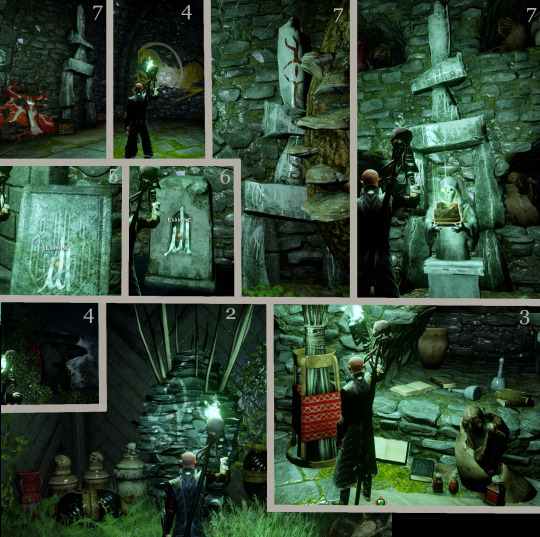
We can find black inuksuit and all its variations [2, 7], the constant presence of the Vallaslin ink in the shape of a white bell-like bottle [3], Dalish hide fence with drawings of branches on it, elven boxes, paintings [4] related to the post Nation Art: Elvhen, the Elvhen funerary lid [5], squared stones with the shape of an eluvian on them that in some places they work like elven epitaphs [6], more inuksuit and variations of them, in this case this one appears in two versions: with red marks, and in the chamber of the Forgotten, without them. And more books and urns. As we can see, the majority of the elements here are death-related.

The temple has several chambers, each of them with a particular name and a statue associated with it which holds a piece of the High Priest.
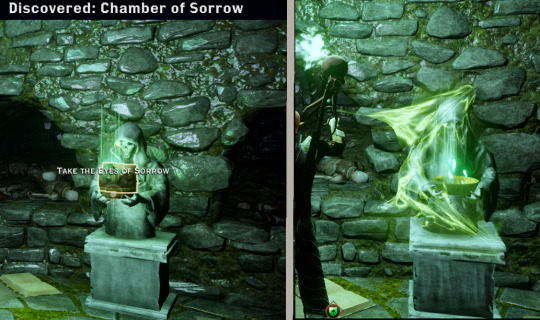
When you take the item, the statue has a Fade-rift like effect, and triggers a fight with arcane horrors.

When you pick the first item, the inquisitor notices a warmth to it. Cole will say it’s alive, and Solas will add that it’s alive because it’s connected to the original creature [video]. Once more, the game delivers to us the repetitive concept of the “one piece of the whole” [Flemeth, Corypheus, and this High Priest share in common that through small bits of themselves they can continue existing in different ways]
Honestly, this Temple is super boring to show in screenshots while exploring because all rooms have fancy variations in the way they display the same objects, but at the end of the day it’s always the same objects over and over. It’s more than clear to me that this Temple worked a lot more like a catacomb than anything else. In fact, we see in this whole temple 100% the theme of Falon’Din and little to nothing of Dirthamen. We even find his mosaics in the Sanctuary, but we don’t find Dirthamen’s mosaic, for example. There is even a unique Red Mosaic of Ghilan’nain, right beside the Path of Secrets, implying that she may have had some dark secrets [this is the closest hint to the theme "secrets" we have to represent Dirthamen in his own Temple]. We only find the owl statue in the main chamber of the temple, which is extremely questionable to what elven deity truly represents, as we saw in the posts of Exalted Plains and Emerald Graves. Once more we see that Dirthamen and Falon’Din are almost the same, and one would even risk to say that it's more about Falon'Din most of the time. This temple is less about secrets and more about death.
Explorers of the Temple

The exploration of the place triggers bits of notes of the recent Explorers in the Temple, at the same time that updates the codex The Lost Temple of Dirthamen. The first note of the explorers, Explorers in the Temple (collection of notes), is found in the same moment we enter the Temple. I spoke about this note above. It's basically a presentation of the archivist Gretien.
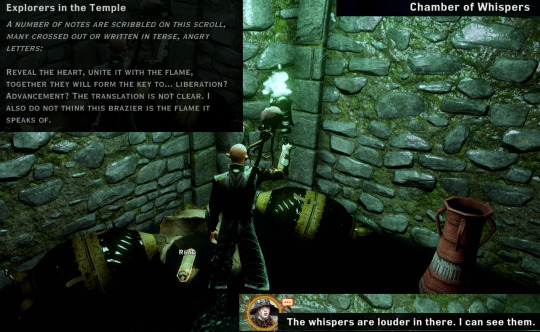
The next note Explorers in the Temple (scribbled notes) is found at the end of the main corridor, which basically shows the scholar's guesses about this ritual.

Returning to the collapsed corridor, we find an entrance with hallas, followed by Archers guiding our path. At the side of this path there is a mosaic of Falon’Din and on the other side, a barrier with many funerary elven elements.

When we remove the barrier, we find another note Explorers in the Temple (small chest), and a dead harlequin, a rogue hired by orlesian nobles as bodyguards. Does this mean that the scholar was attacked? It’s not clear what killed this person. The barrier is up, so it had to be something that could enter that barrier and go away, unbothered.
The note says that some people came to Gretien in the night, looking for Dirthamen’s wisdom. Apparently some of his hired mercenaries wanted to have his part in this just for the money. But the way in which this text is written, one has the impression that the scholar was suffering paranoia.
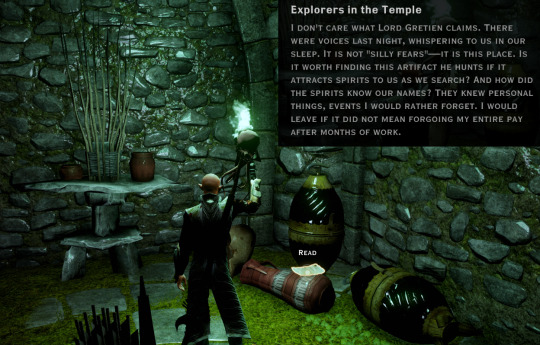
The next note is Explorers in the Temple (note on a vase), which implies that some hired mercenaries had been experiencing those whispers and Gretien had dismissed them. Here, another mercenary says that they had been working for months, so they are unwillingly to just leave, but they truly want to.

In another chamber we find a corpse around books. It’s hard to know if this could have been a recent explorer from the group of Gretien or a treasure hunter that came years ago, considering that the models DAI uses for dead bodies are always the same, no matter their race or time.
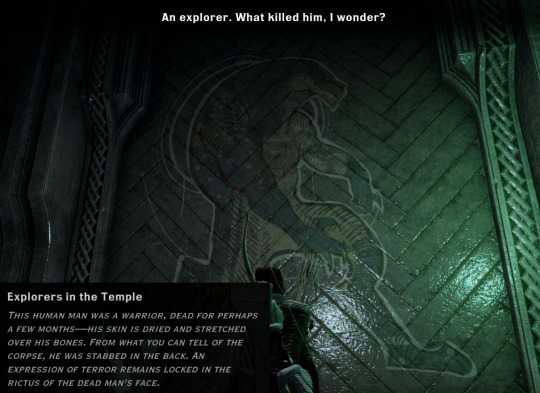
When accessing to the Sanctuary, on one of the sides, we find a body that triggers the last note Explorers in the Temple (human corpse), where the body seems to have been dead for about some months, his skin is dried and stretched over his bones [which is a very unnatural death and preservation of the body in such a moist ambient like this Temple, where water is everywhere]. He was stabbed in the back, meaning that he was killed when running away and his face has an expression of terror. As we will understand later, this mercenary was able to trigger the ritual and was killed by some of the demons, hence his face and the drained state of his body.
This implies that after a summoning, the parts of the High Priest return to their original pedestals by their own. Creepy.
The final note of the Explorers of the Temple is on the main desk at the centre of the ritual chamber. I will talk about it in the following section.
The Lost Temple of Dirthamen: Part 1 - Part 2
[Index page of Dragon Age Lore ]
#elvhen design#elven design#inuksuit#paintings#Sitting Fen'Harel statue#Dalish ink#Elven Archers#Falon'Din#Elven hart statue#Red inuksuk#Evanuris Mosaics#Elvhen funerary lid#Playing DA like an archaeologist#warmth and pulse
9 notes
·
View notes
Text
Exalted Plains: Var Bellanaris
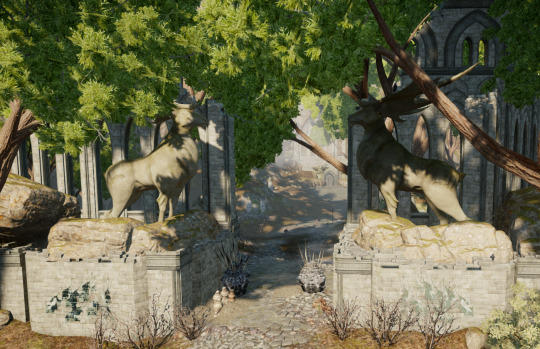
Var Bellanaris can be translated as "Our Eternity." Hundreds of elves have been buried here. Although this land now belongs to Orlais, this part was never reclaimed by them.
[This is part of the series “Playing DA like an archaeologist”]

The entrance of this graveyard has a landmark related to Gisharel, so once more, it’s an unreliable source. The entrance is decorated with hart statues and the walls have paintings of the elves ridding hallas in battle. More details in Nation Art: Elvhen.
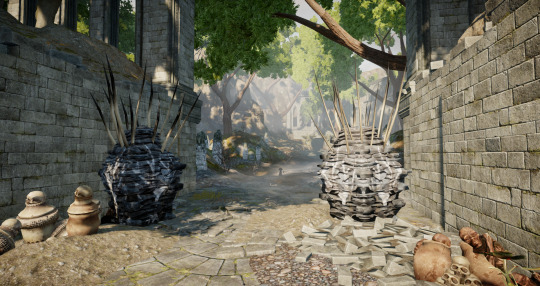
As it’s expected from a graveyard, it’s filled with inuksuit and urns of many types.

Here is where we confirm that those stone lids with a strange symbol are always related to elven graves.

Curiously, Ferelden [in particular in the Hinterlands] shows a similar design in grave lids, but the symbol on them is of an avvar/ferelden mabari.
As it can be seen, those lids cover the urns inside the earth. Each mound is protected by a wolf statue. Now, I can’t say this is an ancient elvhenan ruin originally, or it was part of an elvhen ruin repurposed as a graveyard by the elves of the Dales.

Considering how things are in the Tomb of Elandrin, I don’t know if the original elvhenan ruins had the purpose of being a graveyard. But I think it’s safe to assume that the use of wolves on these mounds where the Dales elves were buried looks like something typical of the Dalisk Kingdom time: the Emerald Knight had companion wolves that protected them and fought with them, accompanied them even to death, so it seems natural to think that their wolf-companion represented in the shape of Fen’Harel statues would stay guarding their resting place for eternity. It also makes us think that the Elves from the Dales did not have such a negative perception of Fen’Harel and his wolves.
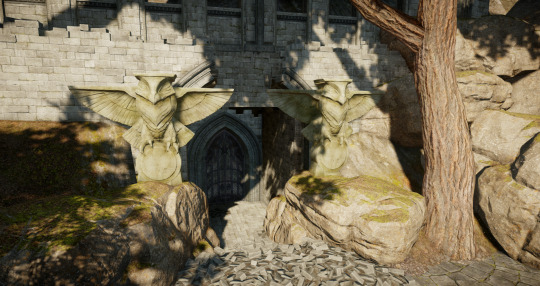



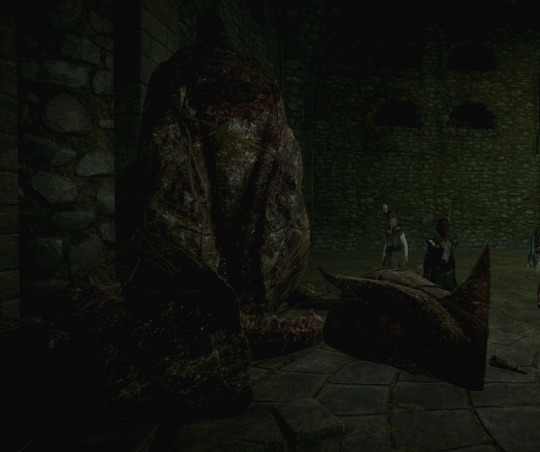
The only “Falon’Din detail” we find in this place is at the entrance to the underground ruins: Unadin grotto [the images have been altered with more brightness that they truly have because it’s impossible to see anything in them otherwise]. Inside we find typical inuksuit that mark this place as a crypt, some offerings, like incense, urns, and a broken statue of Dragon-Mythal.

In front of three tombs of stone there is a stair that leads to another chamber where we see more tombs placed in different and important spaces along it. In the middle of it there is an urn in front of a small mausoleum. It feels like in this place, important Dalish may have been buried. But clearly not the most important ones, since in Emerald Graves we find the tree-graves for the most iconic Emerald Knights of that time.
At the base of the Archer statue, we find a single Red inuksuk.
[Index page of Dragon Age Lore ]
#Exalted Plains#Playing DA like an archaeologist#Sitting Fen'Harel statue#Elven hart statue#Elvhen funerary lid#Elven Owl statue#Elven Archers#Red inuksuk#Dragon Mythal statue
8 notes
·
View notes
Text
The Crossroads [DLC Trespasser]: Forgotten Tower and Hidden Hollow
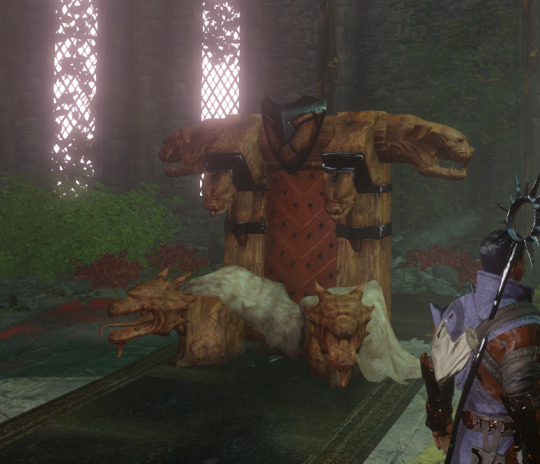
Through the Crossroads we access to two hidden spaces: The Forgotten Tower may be located along the coast of Volca Sea or in one of its isles, and the Hidden Hollow, which location is unknown, although its visual may suggest a place along the Waking Sea due to its similarity to caves of the Storm Coast.
[This is part of the series “Playing DA like an archaeologist”]
[Index page of Dragon Age Lore]
Forgotten Tower
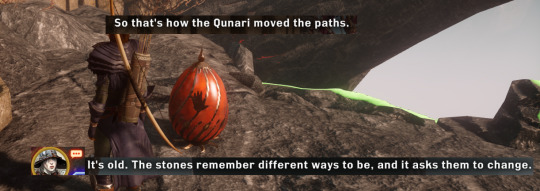

When we charge these dragon eggs with Fade energy from the Anchor, they allow the creation of stone bridges. Cole says something curious about it: these eggs are old and ask the stones to change, so they do.
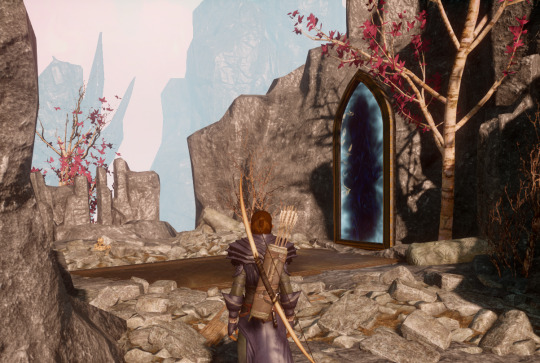
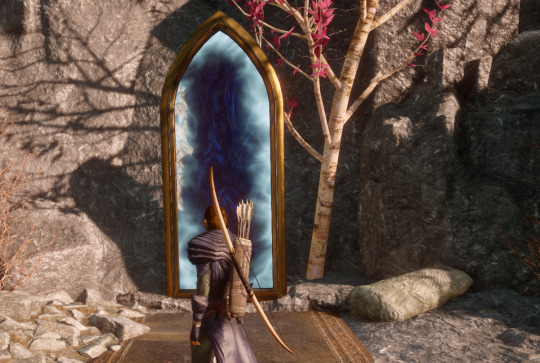
Using the egg from the isle that leads us to the Deep Roads, we reach the Forgotten Tower. The entrance to its eluvian is decorated with a Chasind rug, and some rubble where we can find a Monolith with swirls.

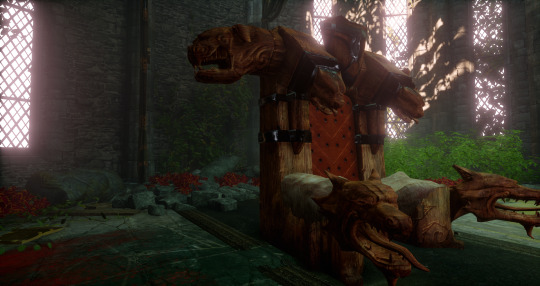
Inside we find a throne along the continuation of the rug. This room has no doors to go outside, or latch to go down if it is a tower. It’s a strange space, giving you the idea that there is no way out but through the eluvian. Maybe some latch is under the rubble, but it can’t be found. According to Skyhold decoration, this is a Ferelden throne.
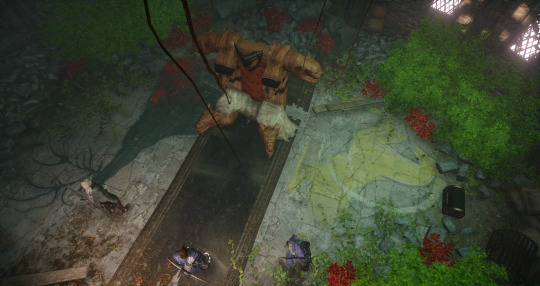
Beside the Chasind carpet we find two drawings on the floor: a golden halla, and a red-stained black halla. Despite being a Ferelden tower, something related to elvhen have been here since these paintings belong to Nation Art: Elvhen.

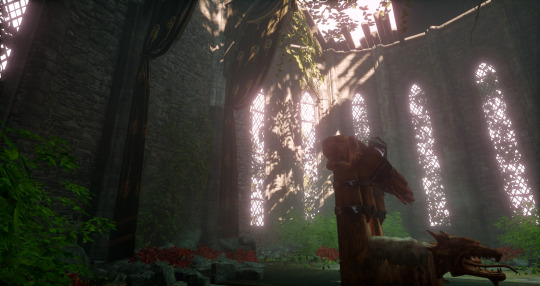
There is some overgrowth in the room, and there is not much to say about the tower. It’s a small space, with an architecture that resembles Ferelden construction, but it has Dalish details such as the curtains and the elvhen paintings on the ground.

Behind the throne there is some rubble where we find a Dwarf with long limbs, a beheaded Mabari statue and a Monolith with swirls.

On the ground we get a Moldy Journal, written in a strange way for my knowledge. This seems to be written by an Anderfelen person who met an elvhen in this tower. A deeper analysis of this codex and part of this tower can be found in Old Codex: Mouldy Journal.

When we open the chest, two revenants appear.

And then we have access to the items for the set The Taken Shape and the upgrade of the codex. A detailed analysis of these items can be found in The Taken Shape set.
Hidden Hollow
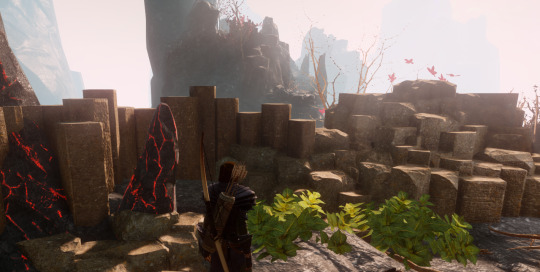

Around the corner of the isle where we have access to the eluvian that send us to the Deep Road, we find some rocks with red marks. I suppose these are small infiltration of red lyrium? The usual colour of these glowing rocks is green in the fade. These disturbed me a bit. They don’t truly look like red lyrium, but it’s only normal to fear. There are some elvhen funerary urns around the eluvian. Once more we see how the local environment of the eluvian reflects its destiny [which I think it’s also a game mechanics to help the player to identify them easily].

After so many months of extensive analysis and repetition of symbols all over the game, the first impression I get when entering this room is about “sacrifices” trying to hide. This space reminds me the first part before entering to Ghilan’nain’s Grove, where there is an excess of bones and elements of death.

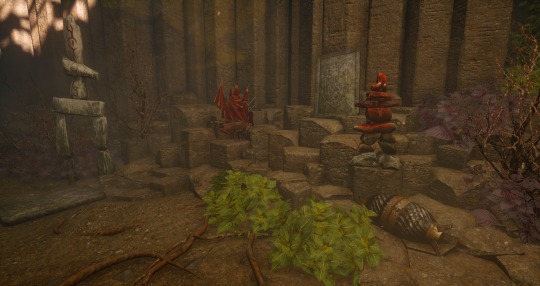
There are several inuksuit: the Red inuksuk, that I always associate with slave elves that marked places of sacrifice or where their blood will be spilled. There is also a white inuksuck with red swirls drawn on it. We found this element in many elvhen crypts or graveyards but also in the Emerald Graves to mark those Emerald Knights that had fallen during the Exalted March.
There are several Elvhen funerary lids and elven urns, and a curious element standing out from the rest: a small miniature of an aravel. This is not an Aravel, but a miniature of it. Why?
If we stick with the idea transpired in Tevinter Nights: The Horror of Hormak, we may relate it to slaves sent to places where terrible experiments of transformation were committed onto them. This Hollow is made of stone, and in some way, we can consider it potentially located somewhere around the Storm Coast, where these kind of caves were common. Hinterlands also has one of these around the Lake Calenhad [around the corner where we fight the dragon] and close to the main town Crossroad: a Wolf Hollow decorated with avvar statues where we finish the Quest of the black wolves.
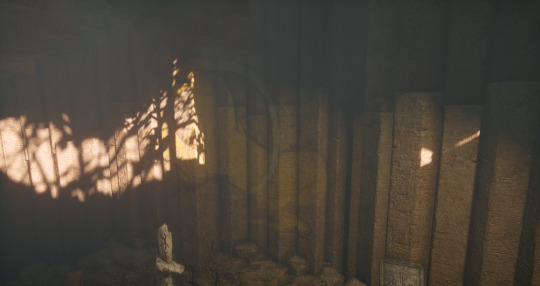
On the wall, there is a big golden halla.

In the centre of the room there is an Elven hart statue. If we remember Exalted Plains: Ghilan’nain’s Grove, we can relate this place through this statue to Ghilan’nain and Andruil, and to a place where sacrifices are gathered.

On the other side of the room, we find another Red inuksuk and a mural of a red-stained halla. The same two paintings we found in the Forgotten Tower.
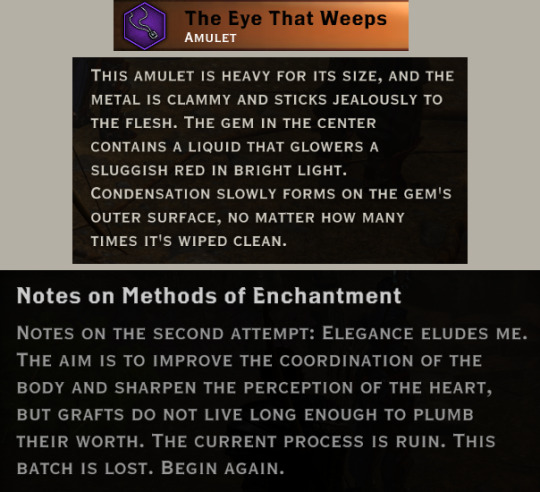
When we open the chest, demons of rage and despair appear. After that, we can take the item of The Taken Shape set, and an update of the codex.
#dlc#dai trespasser#Playing DA like an archaeologist#Monolith with swirls#ferelden design#Dwarf with long limbs#Mabari statues#Red inuksuk#Elvhen funerary lid#elven urn#aravel#golden halla#Elven hart statue#Ghilan’nain#Andruil
4 notes
·
View notes
Text
DLC: Jaws of Hakkon - Frostback Basin, Razikale’s Reach

Razikale’s Reach is an outpost of Tevinter, developed before the Blights to reach Razikale when she went silent. The underground level of the building seems to function like an aqueduct that drained the lake that was placed where the swamp Kulsdotten is now. The level seems to host a generator of energy.
[This is part of the series “Playing DA like an archaeologist”]
[Index page of Dragon Age Lore ]
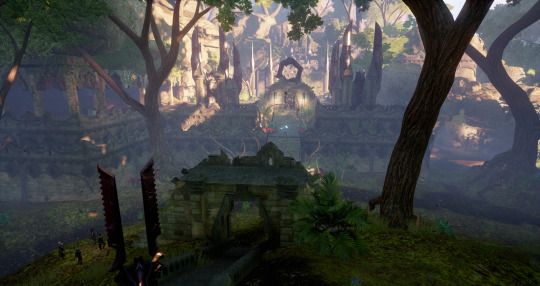
Outside we see the “diapason-like” device that later we will understand its function: they carry energy. The outpost is decorated with typical Tevinter style, claws, and dragon gargoyles. There are some devices on its battlement that are related to the activation of the bigger mechanism inside the outpost.
The entrance

Close to the entrance stairs, the codex called Razikale's Reach can be triggered. The source of this codex is Ser Niguel, a scholar that Collete respects. Ser Nigel is an orlesian knight and explorer we know little about to truly trust. Since he is not a man who lived during the Ancient Tevinter or the Elvhenan time, clearly he will always use worn-out information and interpretations that will reflect his own culture. So I would not trust him when it comes to understand these ruins.
The codex tries to explain why the Tevinters left this place, but this is based on what some Avvar believe [not on the opinion of an Augur, which communication with the spirits allows them to have access to information of better quality], so in short, Nigel never knew. We could suspect that maybe it’s related to the elven temple underneath, since this Avvar says that he suspects the Tevinters did “something terrible” but the avvar did not explained. Maybe they were the ones that forced Hakkon into the flesh of a dragon and this abomination killed them all. Somehow, from this situation, the ancient Hakkonites took advantage and control on Hakkon ages later. Sadly, all this is speculation since there is no real evidence of what made the Tevinter disappear in the region.
As a nice detail to make us suspect that the Veil is very thin in this area we see a pair of Felandaris at the entrance.

The entrance of Razikale’s Reach has a door with the same characteristics than the doors of the fortresses we saw in Western Approach. So these doors seem to be related to ancient Teviner buildings independently of the gods associated with those constructions. [For more details about the symbol on this door, read The Still Ruins, Main Chamber and Hall of Silence and The Unknown Ruin [Mihris]
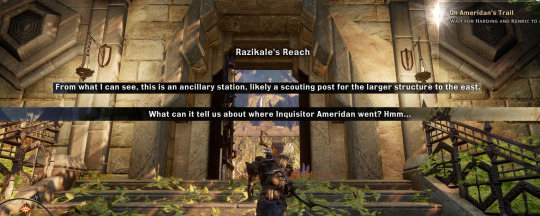
When we bring Kenric to this place, he will tell us things we suspected already: this place is a secondary building, like an outpost that warned the big citadel at the East.

On the battlements we have several elements, among them a big hexagonal structure that depicts two dragons eating each other. This element is repetitive in Coracavus and in the Still Ruin: we see these dragons in white columns eating one another in straight lines along the walls.
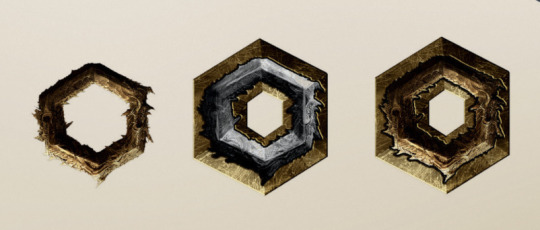
In concept art, these dragons belonged to a very intricate device or object that was supposed to be part of the astrarium but it never made it into the game.

Beside this hexagonal piece, there are two small buildings with claws and spikes that have at their front the typical Tevinter dragon gargoyle,
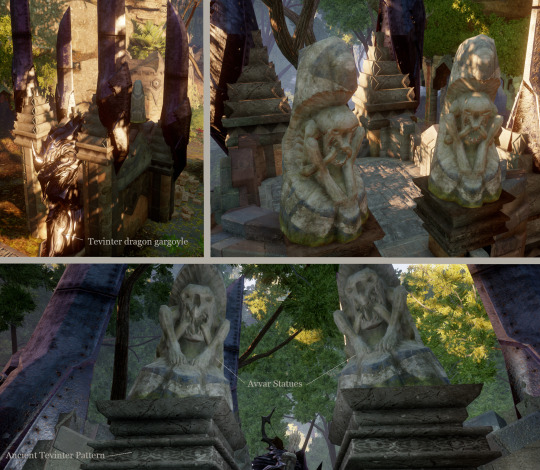
On its back, two massive Avvar statues can be found. This is not strange, Kenric told us in the same moment we started this DLC that buckles are an amalgamation of different times and elements that speak of the history of the whole thing. This is what happens with these ruins. Originally Tevinter, this ruin was abandoned mysteriously by them, and were taken by the Avvar, so they decorated them with their own elements. Later, Ameridan activated and used this place, adding elven and andrastian elements to it.
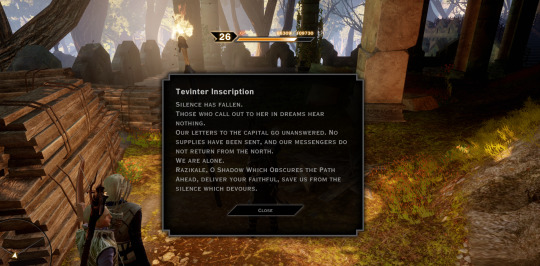
To a side of the battlements, we can trigger a note called Tevinter Inscription. It looks like one from the time in which this fortress was made. It gives the impression this is written around the time the First Blight. We know Tevinter suffered a lot during that time and was forced to focus inwards, leaving all the dependencies they had in the south to their own devices. This is what looks like in this note: Razikale, like Dumat, had fallen silent long ago. Now, Tevinter itself [Minrathous] falls silent too, with unanswered letters and no supplies.
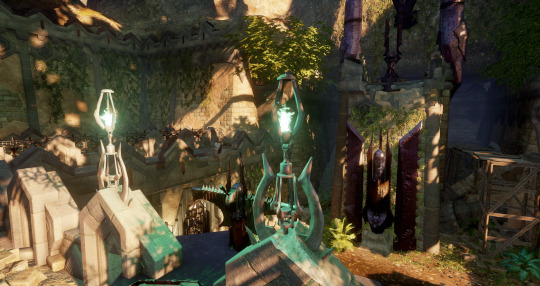

Behind the big hexagonal snake device we find this one which seems to have some Fade-essence or Veilfire in it. It’s aligned so that it can feed energy to the main mechanism inside the big chamber of Razikale’s Reach to redirect it along the map and reach the citadel’s gates.

In the central part of this ruin, in the middle of this diapason-structure, we see one of the Tevinter artefact with spikes [the spikes are looking at the wall] which function is still not clear. The “diapason” structure has been seen before in the Fade under the quest “Broken Window”.
The Tiles and Side Rooms

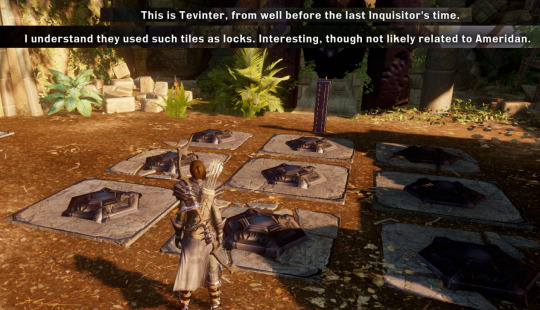
The ground has several tiles that Kenric explains they were used for locking and unlocking doors. They are located in front of the Tevinter artefact with spikes . The tiles are made with the same hexagonal object that decorates the door that opens up when we solve all the astrariums of a given region. Kenric also tells us that these ruins are pre-Inquisition, which is something we have guessed already just by reading the Tevinter Inscriptions.

If we solve the tiles, we have access to two roofless rooms that contain loot. One of them is Hakkon’s Mercy, which I suspect means that the Hakkonites already knew how to use these rooms. And the other room triggers the note Tevinter Carving (The Old Drains). It seems that during the First Blight, the people in here started to fight each other for a throne that doesn't exist. It's said that blood sacrifices on the stone are the only truth they reveal. Quite cryptic.
The other chest only contains fade-touch materials and crafting materials, implying once more that this place has a very thin Veil [we have exotic plants in the altar, felandaris around, and fade-touched animals].
The Aqueduct
Due to the name of this note [Old Drains], and due to the configuration we see underground this ruin, one is inclined to think that Razikale's Reach was meant to drain the lake that was in front of the citadel.

We have access to a door that lets us enter to the Old Drains, where we find Tevinter doors and ancient Tevinter constructions. We reach a stairs that lead us down to an aqueduct system.

Here is where we see these canon-like artefacts with the function of pouring water, hence I called it Water dispenser. Clearly there is an abuse of usage of assets, like placing that diapason-like artefact on the ground to make it look like a mesh strainer.
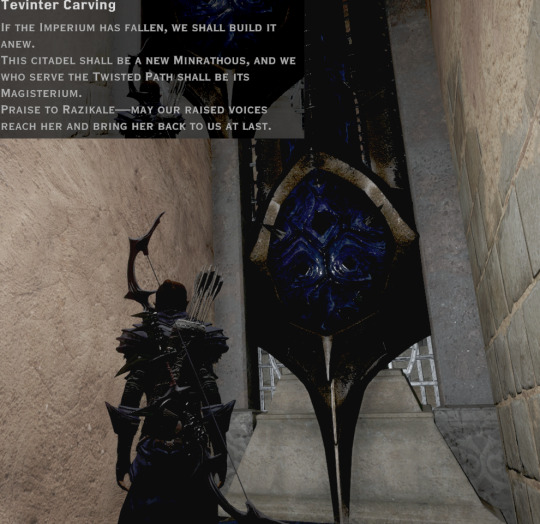
At the end of this narrow corner, we find another Tevinter artefact with spikes. It triggers the note Tevinter Carving (Razikale's Reach). In which we read that after assuming that Tevinter had fallen, probably due to the lack of communication, the Tevinters in this are planning to build a new Minrathous, referring to the Citadel they built at the East of this region. And those who serve the twisted path [probably meaning Razikale’s priests and disciples], were going to form the new magisterium. Probably this situation is what made them fight each other for a "throne that doesn't exist" as it says in a previous inscription.
River Varsdotten

If we continue and explore this place we find a long cave with an inner river from which a lot of overgrowth extends.

Some iconography of Fulmenos / Hakkon and Korth, the father-mountain, are found. This information comes from the analysis of the game files [Korth | Hakkon]. The wall triggers the codex A Celebration Of Wardens which I don’t think it brings much information. An analysis of this codex in particular can be read [here]. Sadly this codex doesn't say in what date it was written, or who is this Lady Locke. We only can trust that maybe, at some point, during a time of no Blight, an earthquake opened the land to give darkspawn access to the surface. This seems to be a fact because the zone looks like an underground river, but if we see it from above, the land seems cracked open. However, along some parts of the crack, there are Tevinter columns with claws on their tops, so it’s not clear if this crack is related to this earthquake or it’s Tevinter’s doing.
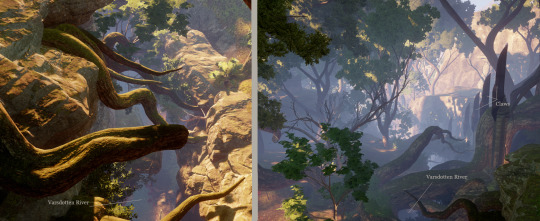
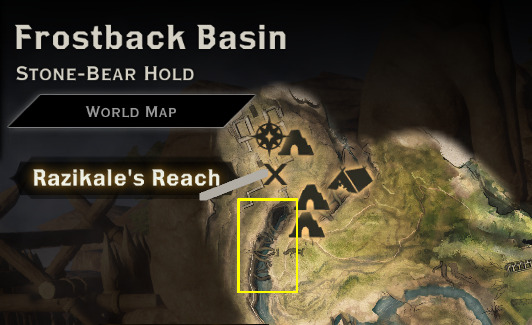
All this place looks cracked in the map and crossed by roots.
According to A Celebration Of Wardens, after several days of fight, the Avvar and the Grey Warden drove back the darkspawn and celebrated. This Lady Locke says that these paintings are from this celebration, showing the alliance between Avvar and Grey Warden and she claims that there are many of these around the basin. We know there are not. This person did not know about Avvar iconography enough to recognise their gods in those paintings. Instead she implies seeing in them the object of her current study: Grey Warden-related things such as darkspawn.
To me this scholar seems to be unreliable, like the guy from the Exalted Plains who called "broken dog" to a Fen'Harel statue. Lady Locke seems to want to write a compilation of the history through the eyes of Grey Wardens, without any other cultural context to understand what she sees. And once more, the game is telling us to be careful on what we read, interpret, and see.
The Ancient Elvhenan Temple

Along this cracked cave we find fade-touched animals [reinforcement of the idea that the Veil has always been thin in this area, reason why the Tevinter built this series of constructions in the Basin: they thought it could allows them to speak with Razikale again]. There are hanged dead bodies that we can’t speculate at all since all dead asset is the same along the game; another isolated painting of Fulmenos, which at this point, it could have been done by the Hakkonites that inhabit this place. And the most important element here: a very ancient Elvhen temple/tomb.
It has all the ancient elements that we have found in Forbidden Oasis: Solasan Temple.
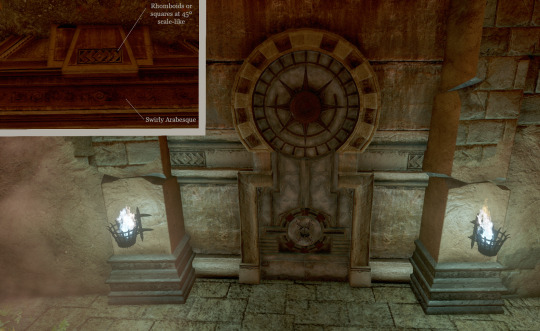
It can only be opened with shards; on its top it has this particular pattern of five rhomboids piled up, some fading swirly arabesques below, and columns that have Tevinter patterns. By analysing the construction, it seems that Tevinter built their outpost around and over this Temple. Once more we have this impression that Tevinter located their main buildings in places that seemed to be related to ancient elvhen temples. The Still Ruins, [Inner Sanctum] is another potential case. Forbidden Oasis has a lot of Tevinter urns and Tevinter presence in a very subtle way as well.

Inside we see the same elements of ancient elvhenan details: columns with bases that are like pilled-up squares and fading patterns of circular flowers.
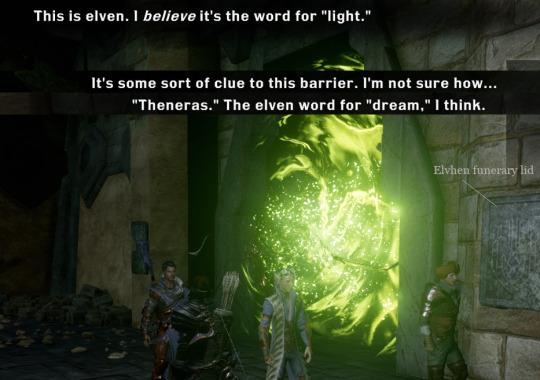
Behind the Tevinter artefact with spikes we see a barrier of Fade-green colour, meaning it’s related to the Fade. Kenric reads some tablet at the sides of the entrance that are what I called Elvhen funerary lid. Here they are used more like an asset. It’s what usually happens with DLCs, they reuse some elements that seemed to have a particular meaning in the base game, and they just smash them in some places to create quick environments in DLC format.
Confirmed by Kenric, this barrier is made of “dream light”, aka Fade essence. Since this place was last used by Ameridan, we realise that ancient Dalish, the ones that belonged to the old elven Kingdom in the Dales, had access to a magic deeply related to the Fade: rift magic, that even allowed them to keep things suspended in time.
Main Chamber of Razikale’s Reach
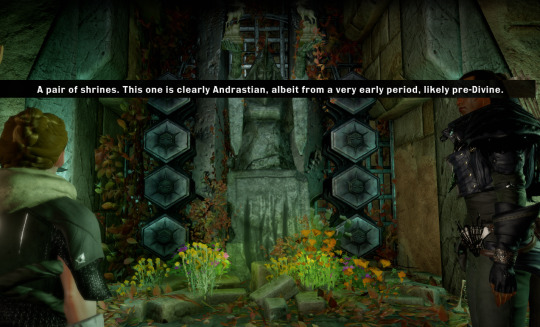
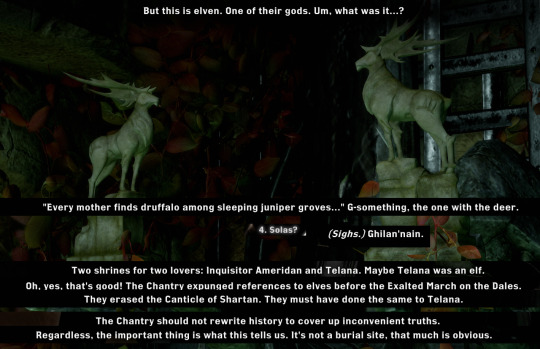
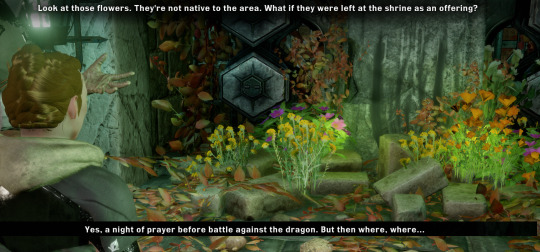
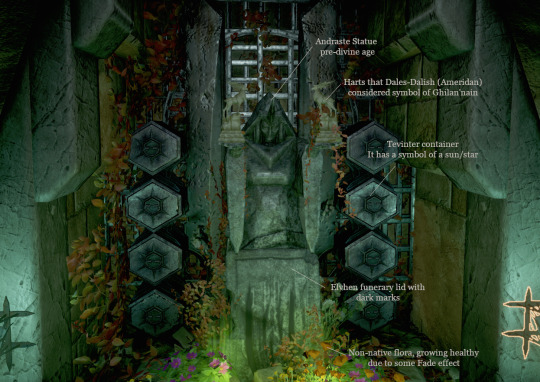
Inside the main chamber of Razikale’s Reach, we see an amalgamation of styles and statues: andrastian, Tevinter, and Elven [like the buckles that Kenric spoke about in the beginning of the DLC]. We find a statue of Andraste, the same one we see in the Fade, which according to Kenric, belongs to a pre-divine age [meaning, probably after the First Blight]
She holds two harts, that apparently, represent Ghilan’nain according to Kenric, to which Solas doesn’t correct or comment anything, so I assume this supposition is kind of supported by Solas. Ameridan made this shrine as a way to honour both mortal figures that reached godhood in different religions.
At the sides of this altar, we see these Tevinter containers we saw in many places already, with the symbol of a sun [I wonder, could the proto-Chantry find inspiration in some sun-like element from Tevinter?]
At the base, we see an Elvhen funerary lid with dark marks.
Let’s remember the chronology of Razikale’s Reach to understand what we see: the land was taken by Tevinter who built several buildings; they did not last long in the area and disappeared. Then, the Avvar who had been around before the Tevinter took control of these buildings, and for that reason we can find some isolated Avvar decoration in them. Around the Second Blight, Ameridan came, and altered these buildings with rift magic and added elven and andrastian elements, because the Dalish of his time had Andraste in high respect for her help against Tevinter slavery and for the promised lands she had given to them [ the Dales]. All this amount of history is somewhat displayed in this altar. It’s like a buckle, Kenric would say.

On the ground, non-native vegetation grows with some sparkles of green that may suggest presence of Fade-leaks that feed them. In all this DLC, rifts and Fade-leaks have been shown to have a more beneficial and positive effect on the environment than the base game. In this case, there is a very curious overgrowth in the Basin that seems to be originated mostly around regions where the Tevinter ruins are located.
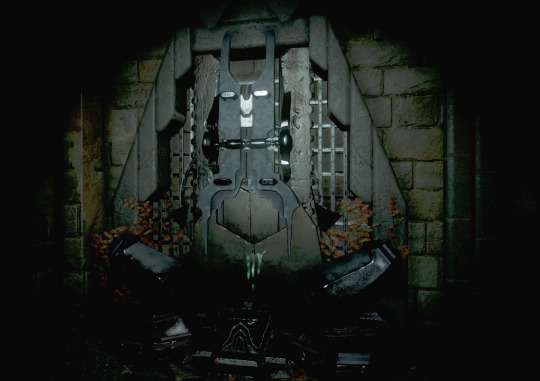

At the sides of the humble altar, there are some devices that were crafted by clipping and pilling up assets that were already in the game: we see a diapason-like device, the same one that in the Fade was related to the Broken Window quest, overlapped with a torture bed, and at the sides, two Water dispenser. This configuration makes me doubt how much I should keep thinking on these elements as objects with a unique purpose that help us to understand the environment. On the other hand, this outpost is related to the aqueducts that drained water from the lake in front of the Frozen Gates [citadel], where the ancient jail is located.
We also find a Tevinter scroll-library and the inexplicable coffins with the lids of Razikale Ceremony and the Horned warrior holding a sword. There are several of these coffins. The only reason I can imagine to explain why these objects are here is that they transported humanoid sacrifices. In some codices we read that they will keep spilling blood to reach Razikale's voice once again [ Tevinter Carving (The Old Drains)], so maybe to think about these coffins as means to transport several sacrifices is not too odd.


If we study the machine, we realise that Ameridan or his lover Telana [also Dalish dreamer] not only knew how to use Tevinter devices, he even combined their meaning with passages of the Canticle of Light, with ancient verses that don't belong to the current Chantry anymore [for example, the one related to Shartan]. This reiterates the implicit information that the ancient Dalish did not only respect Andraste, they could be andrastian at the same time they followed their elven gods. This confirms a lot of suspicions and objects we saw in Din'an Hanin and Elandrin’s Tomb; both buildings of the Ancient Dalish Kingdom when they lived in their own lands: the Dales.
The working mechanism
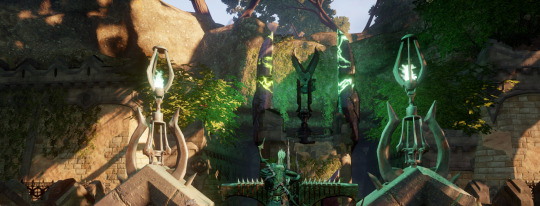

As the group activates the system, we see the spikes-claws charge with Fade/rift energy and a diapason-like artefact accumulate it to beam at the trail marker.
Kenric hypothesises that the way the ancient Tevinter left this place was through the citadel, closing the “door” with this energy that creates a wall of ice.
Once again we are reminded that Ameridan knew how to use Tevinter devices. It could mean nothing, since he could have used it as the inquisitor now is using them. The curious detail is that he used them in combination with Chantry verses to “instruct” its usage. I think this may be a link for us to explain the defence system we find in Exalted Plains: Citadelle du Corbeau, where the device that throws the deadly ray over the citadel is Tevinter but it has been assumed to be Elven, used during the time of the Exalted March.


This is how a concentrated beam of fade-essence starts to jump into different trail markers, making its way to the Frozen Gate. Curiously Solas adds a comment that it shows to me some confidence in how these things work.

Finally, we transport the energy beam to the citadel and it unlocks part of the ice, having finally access to the Frozen Gates.
#Playing DA like an archaeologist#dlc#Frostback Mountains#Frostback Basin#dragon gargoyles#Tevinter design#Dragons in a circle#avvar design#Keepers of Fear#Tevinter artefact with spikes#Water dispenser#shard#Elven Ancient shard-based door#Elvhen funerary lid#Andrastian design#tevinter artefacts#Horned warrior holding a sword#Razikale Ceremony
5 notes
·
View notes
Text
Hinterlands: The Unknown Ruin [Mihris]

When we approach a collapsed ruin, which will be called “dungeon” alone, we find Mihris. She is an important character in The Masked Empire and related to Michael [another char we see in Empise du Lion]. Her clan was killed by Imshael when Michael tried to destroy the demon for good. Looking for vengeance against Michael, Mihris allowed Imshael to posses her, and only another ancient elf in the series [Felassan] convinced Imshael to leave her by promising him that something “big was coming”, hinting Solas’ plan, and that promising level of disaster convinced Imshael to let her go.
[This is part of the series “Playing DA like an archaeologist”]
Updated December 2022
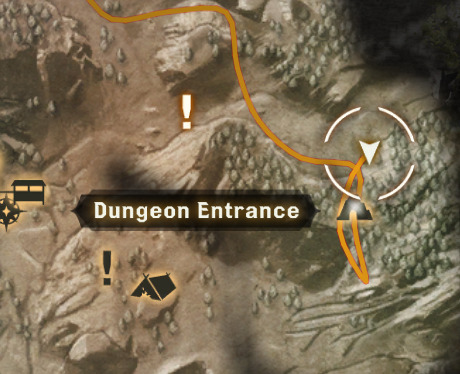

Now, Mihris roams this place because she wants to join another clan and help with the breach.

The place can only be accessed by a mage. The front of this place doesn’t say much. It’s a wall of typical stone, very usual of any fereldan fortress. One would suspect it was built by Fereldans. However there are Avvar pillars and arcs at the entrance of this place.


Once inside, we see a corridor with flags that we immediately assume to display Grey Warden iconography. As it usually happens in most cases in DA series, I assumed this place was built first for some fereldan-based group [the building itself is ferelden, not elven] and then, later, taken by Grey Wardens. Once the Grey Wardens abandoned it, it was retaken by the Avvar. However, in detail, the banners show some discrepancies with the usual Grey Warden symbols. Maybe the first two can be related to them

This one is undeniable: it’s the typical one-griffon symbol of the Grey Warden.
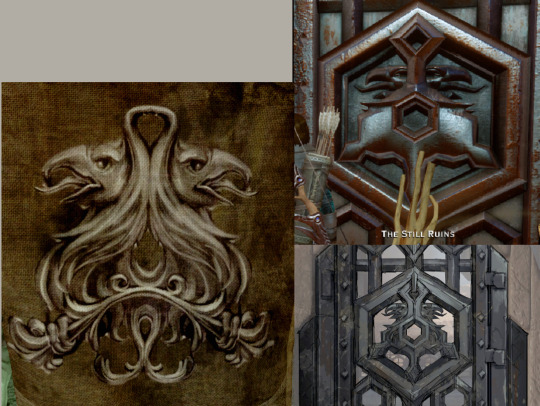
This one, however, does not belong to the typical heraldry of the Grey Warden. I even checked the books of World of Thedas and Art of Inquisition, and the grey warden section does not show similar icon. Where we can see this symbol is in a pre-blight doors made by Tevinter.
This also brings to my attention that the Hall of Silence, in the Still Ruin, is flanked by griffon statues [assuming they are always Grey Warden iconography], which makes no sense in terms of timeline: this ruin was sealed before the blights and only now in Inquisition we are exploring it. There was no way for the Wardens to use it as part of the fortifications against the darkspawn [we saw it untouched and frost in time]. If they would have done so, the whole ruin should be displaying more Grey Warden symbols, not just one in a very particular hall.


As we can see these griffons are the typical Grey Warden statues we find around. They include the joining goblet... so, my main conclusion is that maybe the symbol of the Grey Wardens has a potential relationship with Tevinter. I questioned several times why the Grey Warden have a symbol of a sunburst in their iconography when they are an Order independent of the Chantry, and even older than it. Maybe the answer is related to Tevinter [in what way or how, I cannot say. There is not much to speculate with.]
A combination of both symbols can be also seen in the concept art of Tevinter doors, which shows a more obvious design of the Grey Warden. This is so curious to me.

The third banner is the most mysterious one that I called “Strange wolf-halla-like banner”; I couldn’t find any similar to it in the series of DA.

Looks like a wolf, but it’s not even close to the Fen’Harel banner we have in DAO game files. And its pointy style makes us suspect of Tevinter origin. The only symbols I could relate this with was the symbol on the elven funerary lid:
In the book Art of Inquisition:

Or in game:

It’s more geometrical, and follows the style of the vallaslins we see in the paintings of the Hallas in Nation Art: Elvhen. It’s a design that can be done entirely with just one stroke. Both this drawing and the banner above share a similar structure in different styles. I wonder what this means.

Updated 2023: Recently I realised that the top of this figure is the undeniable symbol of the helm that Tevinter mages use, so maybe this symbols is more related to Tevinter, and like all what it comes to it, previously taken from the Elvhen.


Continuing on, at the end of the main corridor where the banners hang, we find this unique statue that I have only seen in the Fade, in a region where one can assume it’s a representation of sacrifice. The sacrificed lamb. It could also mean “A sacrifice with horns and humanoid body”, relating Gatsy’s Sacrifice murals to this: in that mural we see magisters sacrificing qunari.
This statue is mounted on a device that looks like a capstan, usually seen being used by slaves in the trope wheel of pain, or more typically, to open and close gates that requires a lot of strength. This is the same exact statue we see in the Fade [we can see the “cute” slaves drawings below]

Solas presents us the Veilfire for the first time here, telling us it’s present where the Veil is thin.

As we enter in this chamber, neither the walls nor the arcs or columns of the building give us a hint of who could have built it. It looks very ferelden, since it lacks of the usual elven or dwarven patterns we see in the constructions of those groups. At the sides of the main chamber we see the statue of Masferath, flanked by mabaris, that, due to the position of their heads, seem to be guarding him.


On the other side, we find this mysterious Faceless figure holding a crown [representation of the Maker] and two mabaris in the same position.

The columns and the corners of this chamber usually have this unique, strange statue that, if anything, reminds me of a Skull bud with sword. Because the shape of its background, similar to those big Tevinter diapason devices, I tend to suspect this statue as Tevinter, but I don’t feel very confident on that guessing, so I catalogue it as without identity so far.

On the floor we find one of the typical glyphs of magic. This is nothing special. This symbol in particular is what we see when mages cast spells, more details in General glyphs and magical symbols.

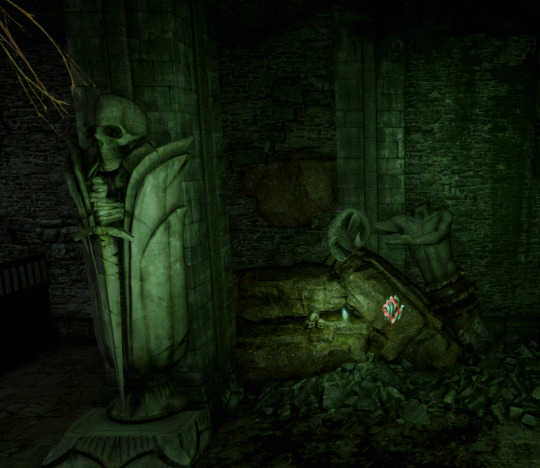
On a collapsed corner we find another Skull bud with sword and the Beheaded ram-man statue. On it, there is a rune which triggers the codex The Lost Art of Veilfire. It’s a book banned by the Chantry, and claims that any mage can control Veilfire, but it’s hardly of the same quality than the elves.
The presence of Veilfire in this place adds nothing of information: the place can be tevinter or avvar, since both group, beside the elves, also knew how to do veilfire.


At the end of the chamber, we see an Avvar altar. The main statue used to craft it is seen only three times in game [in the fade, in the Stone-bear hold, and in the Hissing Wastes]. In this case, it’s clipped with a skull, in front of an urn. It is resting on top of a statue we have seen a lot in the Hinterlands: the Eroded dragon skull.
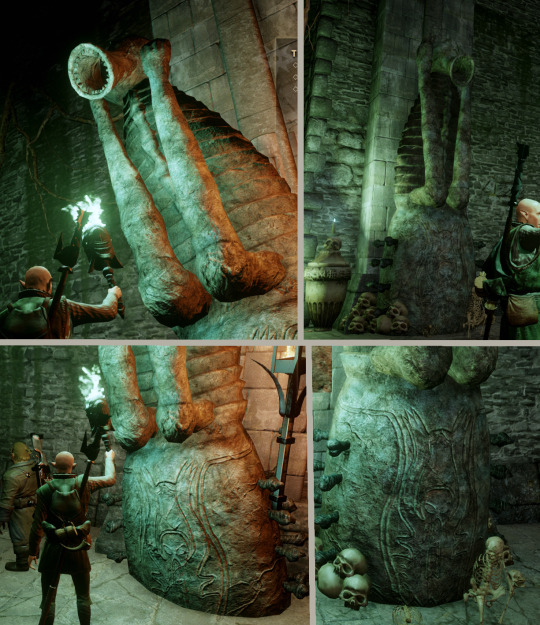
At the sides, there are two statues that we only find in the Fade: they have deepstalker’s mouths and are screaming. In the Fade they are associated with a codex about burning the fears, so it belongs to the Avvar series of Keepers of Fear.

What’s interesting of this statue, is that it’s a central piece of decoration in the Lair of Fear, in the Fade. There, we see fours of these vomiting blood. On its base, there is another drawing, which I can only see as another screaming figure, rising their arms in terror.

At the base of this worshipping place there is an elven artefact.
It’s hard to point out what the hell this place is: It was weird banners, some look like Grey Warden’s but inside the chamber there is nothing related to the Wardens. It has Andrastian and Avvar iconography and a couple of statues which origin is unknown such as the Skull bud with sword. I guess with low confidence that the Skull bud with sword may be Tevinter, but it’s a statue that never had a codex related to it in game, nor appears in the World of Thedas or Art of Inquisition. That statue and everything in this place is such a mystery.
[Index page of Dragon Age Lore ]
#avvar#avvar design#hinterland#Beheaded ram-man#Grey Warden design#Elvhen funerary lid#Strange wolf-halla-like banner#Eroded dragon skull#Keepers of Fear#Skull bud with sword#Faceless figure holding a crown#Mabari statues#Playing DA like an archaeologist
6 notes
·
View notes
Text
Western Approach: Old Chantry Trail Signs
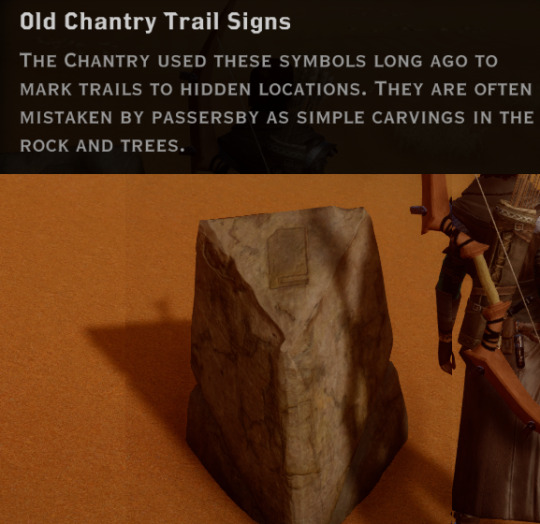
[This is part of the series “Playing DA like an archaeologist”]
There is a strange thing called Old Chantry Trail Sign, which was supposed to show hidden locations. In general they mark caves with interesting things inside. What surprises me is that… depending on the content of the cave, most of the time it doesn’t look related to a Chantry “pilgrimage” along this region. It looks like a co-opt element by the Chantry.
For starting, the symbol on the rock is strange. It looks like a book or a house depending on how you see it. The rock itself is also weird: it’s a triangle. The symbol on it has not suffered erosion, as the stone did.
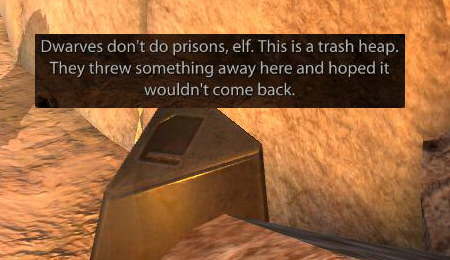
This small sigil has been seen before in DA2. In fact, these objects are all spread over Kirkwall and in Vimmark Mountains [where Corypheus’ prison was located], which function is to offer codices of each part of the city in the former, and to inform about a dangerous entity [Malvernis] in the latter.
In DA2, they were made of metal, so I suspect this object is a Tevinter/Dwarven element used to mark which parts of the city you were entering. In Western Approach seems to keep a similar function, they still mark locations, but maybe they were altered by the Chantry, or maybe they were not altered at all and people just misunderstood the whole nature of this object. I hesitate because we don’t know the source that claims that these things are a Chantry trail sign. It could have been a sign done by the Tevinters in this region, indicating where their fortress and prisons were [there are many in this region, and we need to think that this region looked more like Hinterlands before the Second Blight], and a random guy came here centuries later and misinterpret them, considering them as Chantry-made. What I’m saying is that we don’t truly know what they are, and they are claimed to be Chantry-made when the things they point out [with the exception of one] are not Chantry-like, but reinterpreted as such.
Let’s check some:


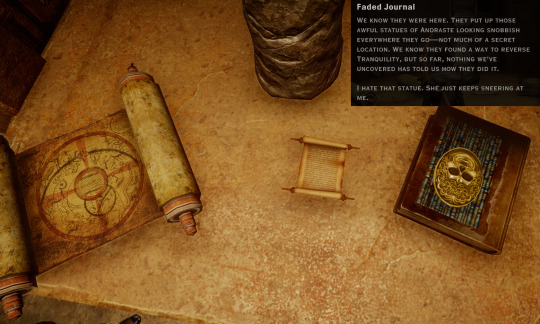
One of the caves gives us a note of a “Lost idol” and a Faded Journal. The note claims that this is a statue of Razikale being worshipped. [More details in the post of The Lost idol]
The Faded journal is very confusing, if you believe that the female figure in the lost idol is a snobbish Andraste. Sadly, this has no author or source, so we can’t trust it at all, neither feed theories about it just because a random person confused a female figure in a Tevinter design for Andraste. Since it also speaks of reversing tranquillity, I suppose it’s a very recent document, older as the events in Asunder in the worst case scenario. This could be the traces left by a character who in the book learnt about the cure of tranquillity. I found it hard to believe that these comments and journals are Pharamond’s, simply because he was a tranquil during his investigation in this zone, and all these codices are filled with emotions and strong opinions, so I don’t know if they tried to retcon what happened in Asunder or this was written by a Templar-bodyguard of Pharamond. I’m inclined to think the latter.

You can only see blocks of stone around the Lost Idol without patterns, unless you move a bit to the background. In there, you see the Dwarven pattern. This cave was done by Dwarves

In another cave marked by these signs, we find a tunnel with two of these curious inuksuit bathed in blood and illuminated with candles that we see commonly used in Chantry-related places. There are some tablets/funerary lids that, with that design, have always been used on Elven tombs or related to elven crypts.



At the end of the tunnel we find the fucker, aka The Strange Idol, but now there is a note accompanying it, potentially explaining it: "The Thing in the Dark" . In the Shattered Library we read a codex which is the only thing that could potentially link this statue with anything lore-related: Elgar’nan. The Thing in the Dark has an ominous message:
This statue is oddly warm to the touch and shivers slightly, as though it might have a pulse.
This description repeats two elements that we have been seeing along the games, always related to Fade/Elven magic: warm to the touch and beating heart movement. Elements that share this, or part of this description can be listed here:
In DA2 [check DA2: The Strange Idol] we saw this statue two times and in both it was possessed or bind to a demon. Merril could feel something in the statue when the demon was bind to it. This could also be the case here.
In the Lost Temple of Dirthamen, we collect parts of the body of the High Priest. They are warm to the touch to what Cole says that these piece are alive, and Solas would explain that this effect is caused because the original creature connected to it is still alive [video]. I dont know if similar mechanism could apply to this statue.
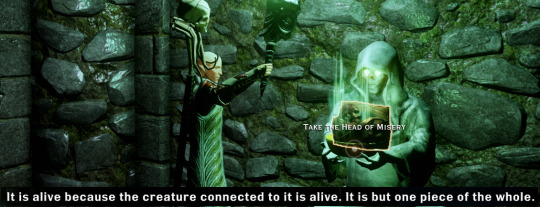
Red lyrium is warm [and angry].
Cole, in the Deep Roads of Trespasser will say tot he inquisitor "Your hand hurts. A heartbeat. Not yours. Hammering the beat of a song in its final verse. I'm sorry." The magic of the anchor has a heartbeat.
In Jaws of Hakkon DLC, Telana [Ameridan’s lover] had a bow with a description “This bow seems to have its own pulse and is oddly warm to the touch.”


Beside the idol there are elven tablets and objects related to elven funerary rites. Close to them we find a book with the codex of The First Blight: Chapter 2. Sadly, the text is written by Genitivi, and like all what he writes, it reeks to Chantry’s point of view. When it comes to ancient history, he is the least reliable source. In this codex we have the same old story of how the blight appeared: The chantry says that the old gods whispered to Tevinter magisters encouraging them to enter the Golden City. Once they did it, they corrupted it with their presence, so the Maker returned them to Thedas, and trapped the Old Gods underground. But with the ancient documents we find in severals pre-blight ruins, in addition to Corypheus' and Solas' words, we know by the end of the game that the Magisters have been unable to listen the Old Gods in their dreams for a long time. They despaired. So, the "true" story told by the Chantry has another order:
The “Maker” trapped the old gods for unknown reasons,
The gods went silent. All the worshippers began to despair with their god’s silence.
The Magisters entered the Golden City, looking for their gods that had gone silent,
The golden city was contaminated already, and the Blight infected them.
This happened underground, from which the first darkspwan came.
Anyways, in this cave we also can loot a chest and find Aegis of the Order, which is a bit confusing. I assume this element justifies the presence of the book speaking about the First Blight. A templar or similar was here. When you relate it to Pharamond’s research, I don’t know if we can consider these objects as elements left by his Templar bodyguards.


For the last place of the trail sign, we head to the South of the region, and we find some ruins that are impossible to identify [they have no patterns on them, they are just blocks of stone]. Beyond them, we find a cave with a magical barrier, and some symbols around that we finally can recognise as truly Chantry-related. This is the statue we saw in DA2 in the Chantry square, the one I suppose it’s Hessarian. There are banners of the Chantry as well.
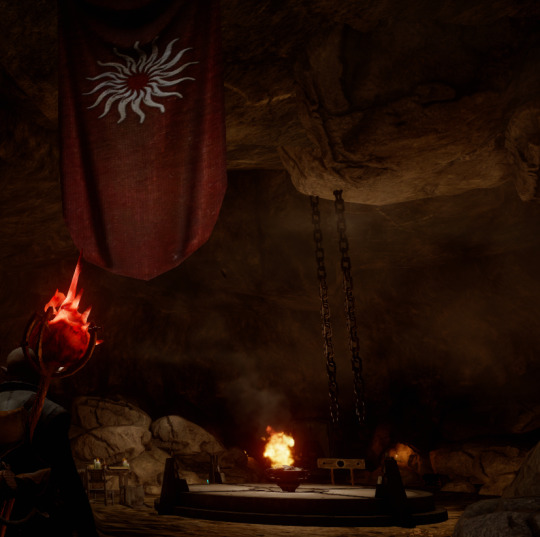

Inside the cave, we find a circle that we saw already in DA2: Legacy used where the guardians/pride demons were sealed in Corypheus’ prison. This one in DAI lacks of the typical torches with the sign “+” on them.
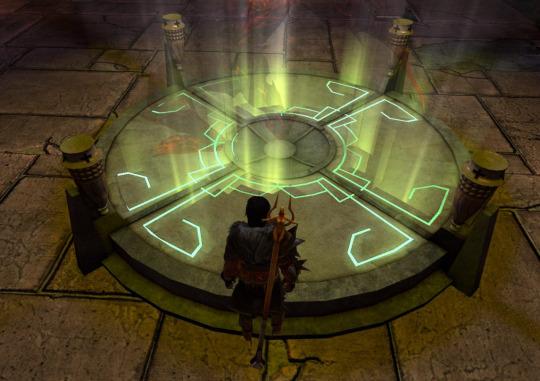
There are two chains hanging from the ceiling which suggests this was a place where someone was held suspended or at least, chained from their wrists, magically sealed in the circle. Here, we find Chantry Loogbook, where those who read Asunder can identify a name immediately: Pharamond, the tranquil that was healed. This codex gives the idea that Pharamond was accompanied by a group [of templars I assume] who helped him in his experiments until he reached Adamant Fort. That would explain the emotional rejection to the “sneering Andraste”, the lecture of the blight with templar objects to loot, and this note. However, I feel there is some retcon here in comparison with the book: Pharamond performed his experiment of being possessed by a demon to cure his tranquillity using a circle inside Adamant fortress. But well, it was easier to leave the fortress for the main quest, I suppose.
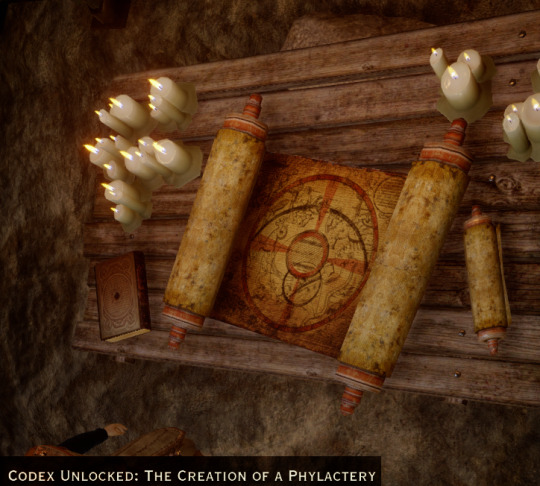
On the table, we find the codex about the creation of phylacteries, which makes the player question how much the Chantry can claim to be against blood magic when they use it for the most basic of the rituals that a mage passes through. And if they do this, then maybe, there are more things that they forbid but practice under some excuse.
[Index page of Dragon Age Lore ]
#Western Approach#Elvhen funerary lid#Strange Idol#red inuksuk#Razikale Ceremony#Playing DA like an archaeologist#warmth and pulse
5 notes
·
View notes
Text
Hinterlands: Tyrdda Bright-Axe Path

Tyrdda Bright-Axe was a legendary Alamarri chieftain attributed with founding the Avvar.
I personally thought that following the stanza [complete saga here] would point me out to Avvar sculptures. But I had strange results.
Also, the way these stanzas are written are quite difficult for me to understand, so any misinterpretation or mistake pointed out would be appreciated.
Updated December 2022
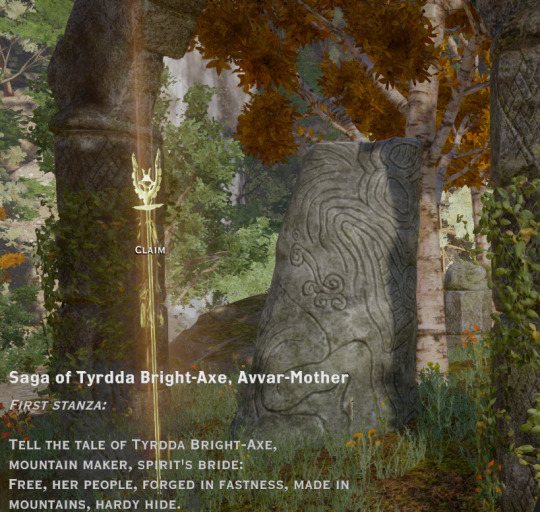
First stanza is given by the wolf/horse statue. It makes sense because it’s an Avvar/Alamarri statue, in the open, surrounded by avvar/alamarri arcs. The first stanza mostly says that Tyrdda was gifted in diplomacy and wisdom, and had a spirit as a lover who had the shape of an elf and it was considered The Lady of the Skies. Here is where the presence of elves among the Avvar shows.
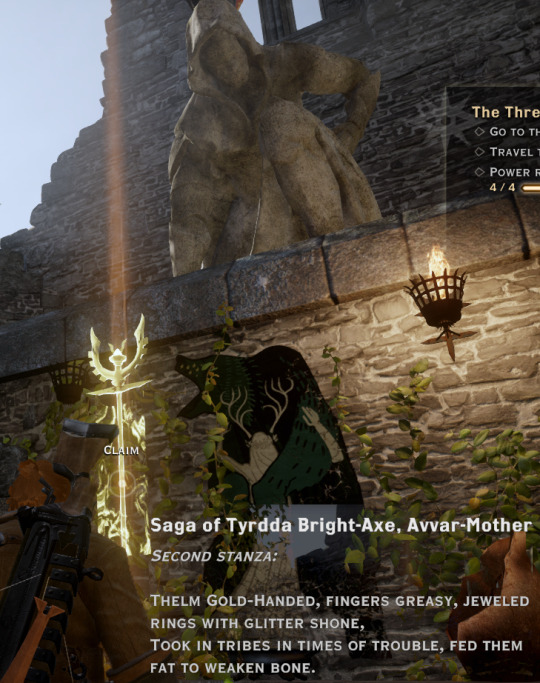

Second stanza… things begin to look very strange. It’s triggered inside the Calenhad’s foothold, which is a recent construction, but we can assume that Tyrdda lived in the zone [close to the Calenhad Lake, after all]. Inside, there are many Ferelden paintings on the walls, and in a corner, we find the statue that triggers this stanza: the one usually considered elven, representing Dirthamen [Or Falon’Din, read the post Exalted Plains: Northern Ramparts and Citadelle du Corbeau for more details on this statue]
This stanza speaks about one of Tyrdda’s suitors: Thelm Gold-Handed, who apparently was a strong warrior; took weak clans, fed them and turned them into his army giving them weapons and armour. Apparently a demon [whispers in his dreams] encouraged him to reach a Golden City in the north. Even though it sounds similar to the Chant of Light, we also have Arlathan which was considered a “golden city in the north” by humans [We know in the Shattered Library that it was blue and more like a sky], so this stanza may mean Arlathan as well as the Golden City for all what we know.
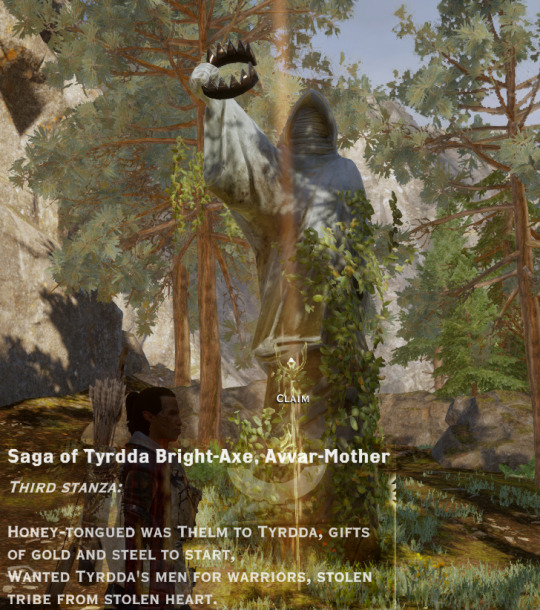

The third one is the mysterious Faceless figure holding a crown. It’s this same statue which allows you to rise an undead, which tomb shows Elvhen funerary lids. Is this statue Elven related? If the executors are an odd elvhen faction, and if that statue is an executor [simply because we can’t see their skin or face], maybe this situation could make a little more sense. So far, to me, makes no sense at all.
Updated December 2022: I finally managed to understand and justify the statue Faceless figure holding a crown. It's andrastian and represents the Maker. The stained glass of Andraste's life represents him as a figure without face with a crown that looks very similar to this one. As The Maker, it makes a lot of more sense for it to appear in the places it does.
The third stanza basically says that Thelm wanted to marry Tyrdda to have her men as part of his army to reach the Golden City. She was tempted, since her tribe was starving due to the hard winter and the promises of food in the Golden city made her hesitate. She looked for the counsel of her elven lover, who saw the lies in Thelm. So that Tyrdda rejected him.
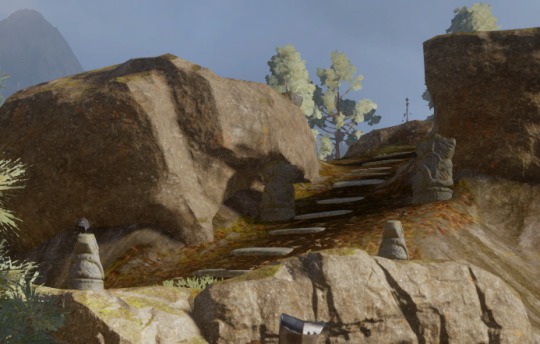

The fourth one is nicely marked on a hill through a path guided by the little guys of long arms and moustache [that I’m fond to consider the avvar representation of Dwarves with long limbs]. On its top, we find this eroded statue that looks like a dragon head [See the post Hinterlands: Statues, paintings, and structures found in the open]
The fourth stanza explains how Thelm did not take the rejection of Tyrdda well and fought her, wearing armour. He damaged her leg, but she killed him by burning him inside his armour, using the staff of her elven lover.
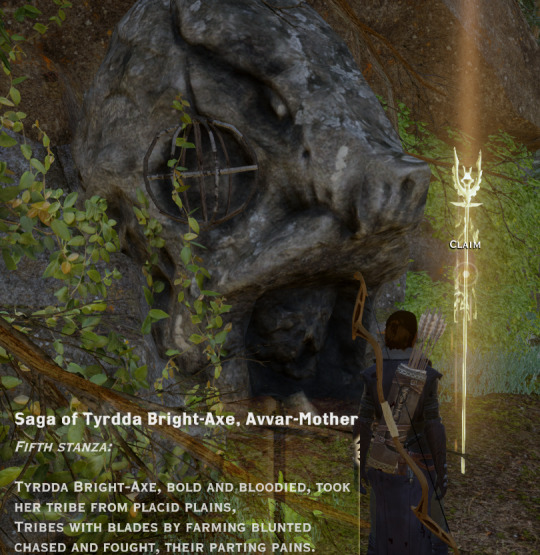
The fifth staza is triggered by a screaming head, one of the Keepers of Fear.
The stanza tells that Tyrdda took her tribe and left the Calenhad lake heading to the Frostback Mountains. They took shelter in a cave where a dragon was found. She asked for help to her elven lover, shouting her: "You I chose above a crown!" and the dragon was struck from the skies, saving the tribe.

The sixth stanza confirms my supposition that this statue is the avvar representation of a dwarf: it tells how after the battle, strong and shaped by the struggles, she went deeper into the cave reaching the Deep Roads, meeting the dwarves for the first time: Hendir’s men. The encounter was tense, ready to attack each other, until Tyrdda’s lover whispered her information to understand these men. She explained her that they were honourable, so Tyrdda chose to trade with them instead of making war.

The seventh stanza is found in the central massive sculpture of crossroads [Hinterlands] that must represent Tyrdda herself. It explains that after spending a night with her elven lover, the elf left her, whispering in her dreams that she needed to have a child in order to continue with the tribe. She had a baby with the dwarf prince Hendir, following the advice of her lover, who told her that one of her line, Morrighan'nan, “will shine in strength”.

The last stanza is found in this place where we can see one of these small sculptures with a dove that I thought were Andrastian. It says that once Tyrdda saw her tribe stable, strong and safe with the alliance with the dwarves, she put her child as chieftain of the tribe and left to the skies to reunite with her elven lover in the afterlife [sky burial].
[Index page of Dragon Age Lore ]
#avvar#avvar design#tyrdda bright-axe#Monolith with swirls#Humanoid Dirthamen/Falon'Din#Faceless figure holding a crown#Dwarf with long limbs#Eroded dragon skull#Keepers of Fear
21 notes
·
View notes
Text
DAI: Ancient Elven codices; The Lost Temple of Dirthamen
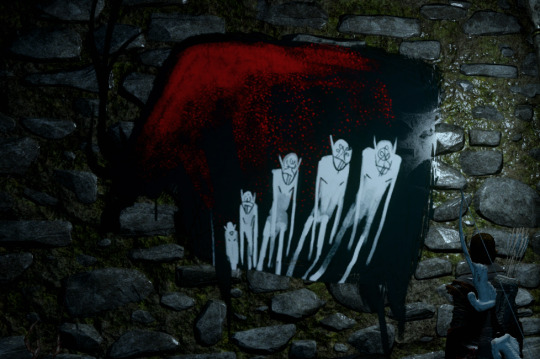
Codices that have a good degree of certainty, closer to the truth of what happened in the time of the Evanuris. I’ve collected all the codices in the said area and I’ve summarise them in bullet-points and implications. Since everything requires Context, some of them will be accompanied with the current location in the game, in order to give us an extra bit of understanding. I usually add my thoughts at the end of the bullet-point list. This analysis avoids the unreliable Dalish Tales.
The Lost Temple of Dirthamen is a place with some issues in my opinion. It was explored previously by treasure hunters, and recently, by an Orlesian scholar. At the end of the temple, we find a dark desk with the symbol of a building that looks Tevinter-esque, suggesting two potential answers: this place has been spoiled with the presence of Tevinters trying to co-opt Dirthamen’s wisdom. Or Tevinter and Elvhen empire were more related than merely Tevinter co-opting elven knowledge and instruments.
The codex The Lost Temple of Dirthamen can be collected along the many rooms and chambers of this temple. All of them have quite creepy names: Path of Shadows, Chamber of Whispers, Chamber of Unheeding, Crypts of the Forgotten, Path of Secrets, Chamber of Despondency. By the end of the exploration we know that each of these chamber contained a piece of the High Priest of Dirthamen, who was bound to this temple through these pieces.
The Lost Temple of Dirthamen explains how a small group of disciples of Dirthamen were informed by their High Priest that Dirthamen was gone. They feared their secrets could be stolen from them, so they despaired. The High Priest tried to comfort them, telling them that they were safe as well as their secrets, but they, as disciples of Dirthamen, could see through his deception: apparently, the High Priest wanted to perform a blood-magic-bound ritual using the blood of the disciples to trap them in this temple [it's our blood he seeks, a sacrifice dark and unholy, a prison of evil to keep us in and all else out]. Loving their secrets despite the madness they cause, the disciples rebelled against this decision and performed a counter-ritual in which they dismembered their High Priest and bounded him with them into this secretive silence.
Interesting things that transpire:
Dirthamen was supposed to be the god of secrets, and his entanglement with Falon’Din is so deep, that most of their stories keep confusing one for the other. At this point, we can’t trust that something is truly Dirthamen’s. This temple has an excess of funerary objects, funerary lids, tombs, dead, etc. There is not even one mosaic of Dirthamen, yet, the main chamber is decorated with two mosaics of Falon’Din. So there is a possibility that this is in truth “A Lost Temple of Falon’Din”.
The disciples feared a group of people that would steal their secrets. By Abelas’s words, we know that their temple had been attacked by the same ones that killed Myhtal: the Evanuris. So I assume that a similar situation may have happened here. The ones interested in stealing Dirthamen’s secrets could have been other Evanuris, or in a late stage of the Elvhenan Empire, the Tevinters, who had been stealing elven knowledge since the Fall of Arlathan.
What the codex implies is that these priests had a deep knowledge of bounding spirits and living creatures. The High Priest did it with the group of the disciples, and the disciples did it with him in return.
There is a unique Red Mosaic of Ghilan’nain, but not any of Dirthamen. After reading Tevinter Nights: The Horror of Hormak, one tends to speculate that Ghilan’nain was responsible for the magic that transformed creatures into chimeras and bounded creatures with different souls one to one another. Therefore, her mosaic in this Temple could potential imply that she also knew some powerful magic related to bounding processes to the point of chimerical transformation.
As a conclusion we can see that the bounding ritual is a repetitive pattern not only in all DAI, but also here, in this temple, including the red mosaic of Ghilan’nain.
Potential speculation:
This mysterious bounding process can potentially be related to the unique, dual nature that Dirthamen and Falon’Din have. I have the impression that since Dirthamen has been the one possessing such secret knowledge and Falon’Din has always been known for his vanity, the latter could have subjected Dirthamen to a procedure of bounding to himself, so both of them became a unique entity, and Falon’Din could have had the knowledge of Dirthamen to increase his followers [Solas implies that Falon’Din’s vanity was really out of control].

It’s also interesting how Dirthamen and Ghilan’nain are related visually through the red mosaic, but also through the codex [ Ancient Elven Writing] where she urged a slave/servant of Dirthamen to take divine shape. Maybe the divine shape is related to a bounding process, similar to the one we saw in [The Horror of Hormak].
All over DAI we see a repetitive theme about bounding spirits/demons:
The Grey Warden and their demon army,
Corypheus is the one granting this knowledge, so the knowldge has belonged to Tevinter too as some point.
In the DLC of Hakkon we have the bounding procedure of the Avvar Mages [more willingly and gentle without catastrophic consequence] but also we have the case of Hakkon: a spirit bound to a dragon.
Although it does not belong to the game, another horrifying procedure of bounding has been recently described in the book Tevinter Nights: The Horror of Hormak
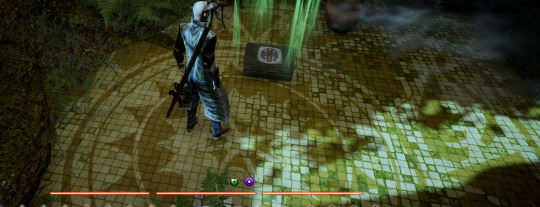
So, maybe the secret of divinity is to bound oneself to a creature of incredible power, which is a dragon in DA lore, or maybe a titan?
[Index page of Dragon Age Lore ]
8 notes
·
View notes
Text
Arbor Wilds: Temple of Mythal - Part 2
Main Quest: What Pride Had Wrought
The Temple of Mythal was a place of justice, where petitioners walked religious rites of passage in order to have their pleas for justice from Mythal heard. According to some it is also the site of some mysterious religious artifact called the vir'abelasan.

This post contains the following sections
Outer Courtyard
Preparation for the Well
[This is part of the series “Playing DA like an archaeologist”]
[Index page of Dragon Age Lore]
Outer Courtyard


When we enter to the Courtyard, we have a conversation with Morrigan and Solas, summarised in:
They realise Corypheus cannot die. He takes control of another blighted creature and is immediately reborn. Archdemons have the same ability.
The Grey Wardens have a way to kill Archdemons despite this ability, however, it seems that they could not apply it with Corypheus, hence they locked him away in Vimmark Mountains.
Morrigan suspects that the power of the Blight is what has given Corypheus this power, but how he gained it, she cannot know [As players, we know already due to the memories of Corypheus in the Shrine of Dumat that he embraced the corruption he found in the Black City, so probably this is what gave him this ability. It's not clear if the Architect has the same power].
Morrigan explains that this part of the Temple is a vestibule, not the temple itself.
She also questions divinity: she says that elven pantheon may have been beings of immense power, in the same fashion that Old Gods are "mere" dragons that rise as Archdemons. She has a good hunch when she says that Mythal may have been a powerful elf who was a ruler.
However, Solas corrects her in a very vague way. Apparently, this description of Mythal felt like a dismissal to him, likely because how dearly he keeps her.
She also questions if Mythal was truly a single entity, which introduces in the player the idea that Mythal may have possessed many bodies before Flemeth.
Solas explains that there are many accounts of Mythal and he only supports, implicitly, the one that claims that Mythal was The Mother [as we see her in the mosaics], protective and fierce.
Morrigan assumes that Mythal is exiled with the rest of the elven pantheon, according to the unreliable Dalish Tales. She also assumes that it may have been Tevinter who simply killed them.
She also suspects these strange elves that protect the temple descend from the ancient ones, before the fall of Arlathan.

In this place we still find these mural paintings. From all these typical elvhen paintings collected in Nation Art: Elvhen, the Temple of Mythal only lacks one: The Armoured Figure. Maybe this detail will help us to understand the painting at some point.
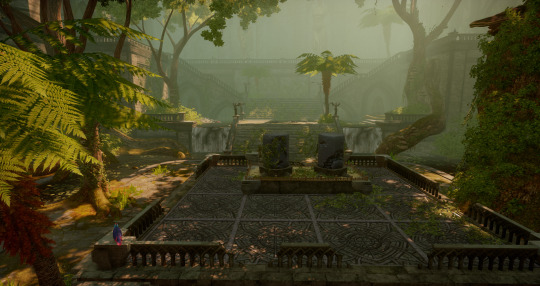
The central part of the courtyard shows a section with elvhen tiles and two short cylinders with ancient writing on them.
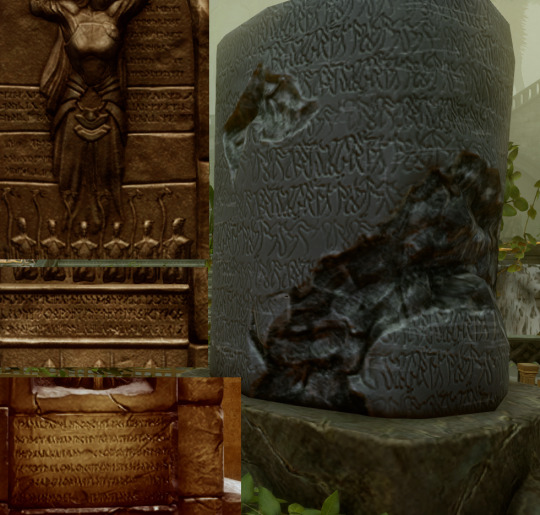
This inscription looks a bit similar [but not the same] to the text written in the Razikale Ceremony or in Horned warrior holding a sword. These grey stones also appear in the puzzle of the Exalted Plains: Ghilan’nain’s Grove and the Dead Hand. Of course the whole temple is filled with many Dragon Myhtal statues and Humanoid Mythal statues.

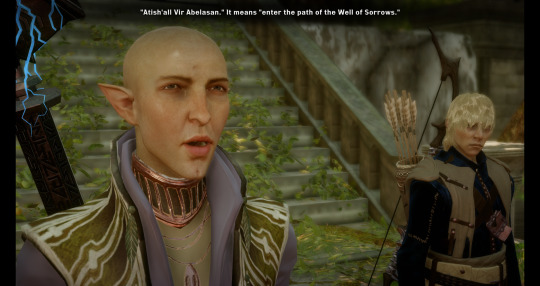

With the help of Morrigan, the elven inquisitor, and Solas, we read the inscription of the grey stones. Morrigan explains that the entrance to this temple is free, it's not like a barred door. But to go further, you must perform the rituals [puzzle] as a way to offer obeisance and ask for justice imparted by Myhtal.

To a side of the vestibule, we find a sitting Fen'Harel with several Elvhen funerary lid, and an elven puzzle box [I found it cute how this element always seems to be close to this statue’s paws, the wolf is always playing with it, it seems. Or it can be interpreted as he being a guardian of a treasure, since these elven puzzle boxes sometimes are mere containers for loot].
Here we can trigger the codex The Rebel God, which analysis was done in Ancient Elven codices, Temple of Mythal. Basically it suggests that after the Exalted March the word associated with (Fen')Harel started to morph its meaning into “betrayal”, instead of being “rebellion” as its etymology seems to point out.

Morrigan is surprised about the presence of this statue in the Temple, she interprets it as a blasphemous gesture. And elven inquisitor will comment that their clan uses this statue in a more "Emerald Knight" way [as a protector of the borders of a Dalish camp]. Solas replies something that reaches to the players: we have to be wary about the legends, about the tales, because even though they may have a grain of truth, they are not historical facts.
I think here is one of the many examples where Solas chooses to omit instead of lying, and the reason why I trust him when he drops a bit of lore. He doesn't lie about history, he just omits it if it's too compromising or painful. We know in Tresspasser that he awoke in a world that felt like living among tranquils. He sacrificed his old world to give a future to the people, but he found out that they had embraced all the slavery icons, romanticised their previous tyrants, and he had turned into a god of betrayal, who had been, poetically speaking, being betrayed by the same people he wanted to save. I don't want to go too deep into character analysis, because it's a lot, specially with Solas, but I think these details are a good justification of his attitude to not answer anything else in front of this Fen'Harel's statue. Plus, in the beginning of the game, we learnt he had tried to share the truth with Dalish clans that mistreated him.

We cross a door that glows in a soft blue and we find a corridor that depicts another of these strange murals. With all what I've already analysed in Nation Art: Elvhen, it seems strange to see them in Mythal's temple in particular.
Preparation for the Well
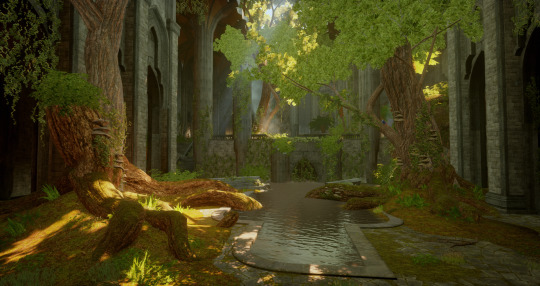


Morrigan speaks about what this place seems to be for her. Solas does not add any comment to correct her, so she must not be too far away from the truth.

As we enter in this new section of the Temple, we have two options to explore: following the path of Mythal, be respectful, and make the ritual-puzzles to be granted access to the Temple, or just skipping all this by following the path opened by the Red Templars.
Solas and Morrigan agree for once: they suggest to complete the puzzles, while other companions will suggest to urge the access. We know later that Solas is asking for this in order to save "part of his People", elvhenan "such as him". He takes the risk of letting Corypheus get the Well instead of letting these people be killed by defending this place. Morrigan, as we know, is a preservationist of the arcane and the old knowledge, so she wants to protect the well and have access granted to it, so she insists in respecting the rituals.
She also calls the Inquisitor to a side, and shares with them the last bit she understood from the grey stone but did not say it out loud: those who use the Well receive a great boon at a terrible cost, the sweet sacrifice of duty. We will understand this later as the loss of personal freedom and will [one becomes a servant] in order to perform a duty, while having a vast knowledge of the ages.



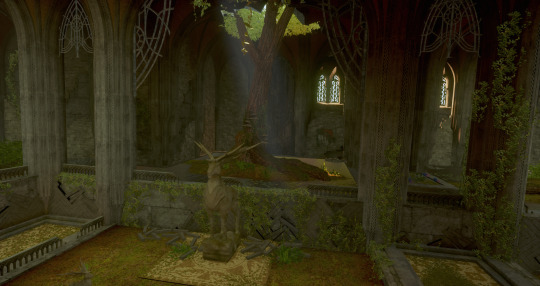


This place is a set of chambers with puzzles and corridors with the standard brown-yellow mosaics on the ground and golden mosaics on the walls depicting some of the gods.


It's curious to me that, despite being Mythal's Temple, we have still these murals of the "zombie" white elves. In the most hidden areas we find Fen'Harel's mosaics, quite decayed too.
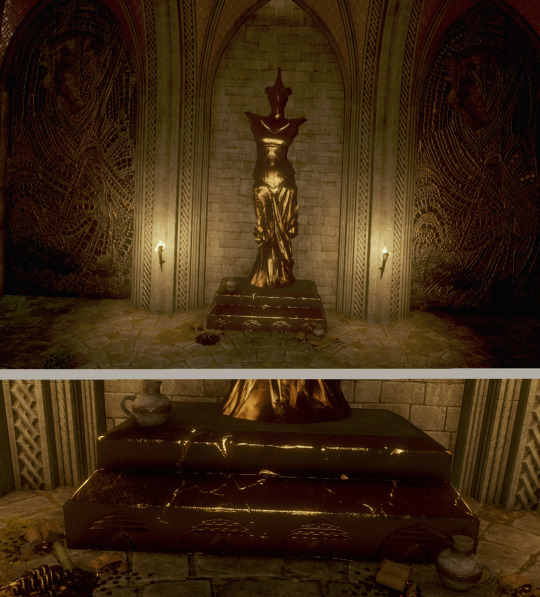
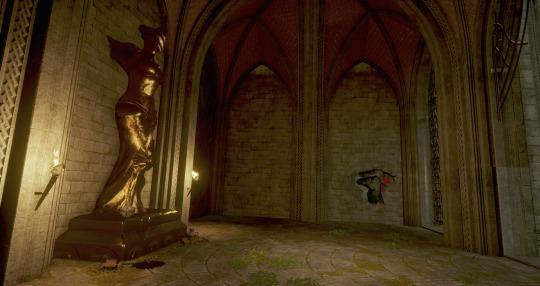
In a small chamber, we find Humanoid Mythal statue in gold, and a golden mosaic of Falon'Din. On the opposite wall there is one of the mural paintings, the shifting halla.

The mosaic triggers the codex Song to Falon'Din, analysed in Ancient Elven codices, Temple of Mythal. It seems pretty curious that he is represented at the sides of the statue, when Solas tells us the following:

After the codex, there is an interesting exchange of info coming from Solas. Morrigan and the elven inquisitor comment their knowledge based on the unreliable Dalish Tales, while Solas speaks from personal experience:
Falon'Din's vanity was so big and his need for adulation so intense, that he started wars to get more worshippers. [It's not clear for me if we can understand this as if Falon'Din would kill other evanuris in these wars in order to take their worshippers and join them to his. So far, in the Ancient Elven codices, Temple of Mythal, we learnt that Falon'Din was eager to almost fight Elgar'nan, and Mythal calmed things down asking for them to solve the situation with a duel of champions. This line also makes me speculate what I said before in the posts of codices or in The Lost Temple of Dirthamen; maybe Falon'Din and Dirthamen had this "twin" nature because Falon'Din somehow bonded Dirthamen [since Evanuris are hard to kill, but not to merge, maybe?] and kept his followers to him, who couldn’t distinguish one from the other]
Those who would not bow, will fill pools as big as oceans with their blood [this is a nice interpretation-twist of a "god of Death", not as a guider in the afterlife but as a mass killer.]
Mythal rallied the gods when Falon'Din started to [I understand] kill Mythal's followers. It was almost late [sadly, Solas doesn't say in what sense it was late]. Falon'Din surrendered only when the other Evanuris [that's how I understand brethren here] bloodied him in his temple. We didn't visit a proper Temple of Falon'Din so far we know. In DAO there were Elven ruins of dubious mixture with Tevinter elements. So we don't know which place this is.
If the Inquisitor questions the fact that such a killer was left alive, Solas reinforces what he told us in Tresspasser: Evanuris are not easy to kill.

Similar chamber can be found across the main place, but the mosaics depict Andruil.
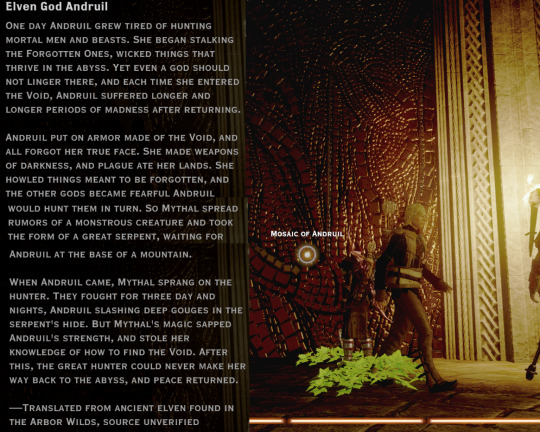
Here we trigger the rich codex of Elven God Andruil, explained and interpreted in detail in Ancient Elven codices, Temple of Mythal.

After it, we have some more info given by Solas:
He knows Andruil was a goddess of Sacrifice.
Even though Solas doesn’t say it, it’s implied that this is the reason why Andruil’s patron animal is the hare, a creature for sacrifices.
Sadly, Solas does not add much more against Andruil, as he did with Falon’Din.
My personal speculation about why these two gods have this preferred place in the temple, is related to the common aspect they have: both were a threat for Mythal in a way or another. Andruil put in danger everyone with her madness and weapons; Falon’Din killed Mythal’s people in his extreme desire for adulation. Maybe this is the reason why these two gods are beside a statue of Mythal, in chambers that have a “wall” made of a golden fence, as if it were a cage.
Arbor Wilds: Temple of Myhtal - Part 1, Part 2, Part 3, Part 4, Part 5
#main quest#playing DA like an archaeologist#Falon'Din#Andruil#Humanoid Mythal statue#Sitting Fen'Harel statue#Elven hart statue#Elven Archers#elven design#elven pantheon#mythal#Elven Owl statue#temple of mythal
3 notes
·
View notes
Text
Design: objects, statues, monuments, and patterns
Andrastian
Avvar - Alamarri
Dwarven
Dalish
Elven
Elvhen
Ferelden
Free Marches
Grey Warden
Orlais
Tevinter
Non-Identified
Visual Post
Patterns and Styles: Elvhenan
Patterns and Styles: Ancient Elvhenan
Patterns and Styles: Dwarvish
Patterns and Styles: Tevinter
Patterns and Styles: Orlais
Patterns and Styles: Others
Unique art/sculpture
Nation Art: Ferelden
Nation Art: Elvhen
Nation Art: Tevinter
Paintings
-- Avvar/Alamarri/Chasind/Felderan --
Mabari statues
Keepers of Fear
Dwarf with long limbs
Monolith with swirls
Eroded dragon skull
Table of Wolves
Tyrdda statue
Ferelden Wyvern
-- Andrastian --
Andrastian Design: Stained Glasses
Andrastian Design: Tapestry and Tryptich
Faceless figure holding a crown [The Maker]
Man holding bigger head
Blocky bearded humanoid
Andrastian Statues
-- Free Marches --
Free Marches eagles
Free Marches Sun
-- Elvhen --
Golden Ring
Elvhen funerary lid
Dragon Mythal statue
Humanoid Mythal statue
Howling Fen'Harel statue
Sitting Fen'Harel statue
Elven Owl statue
Elven hart statue
Elven Archers
Elven Tree Statue
Humanoid Dirthamen/Falon'Din
Red inuksuk
Elven Ancient Shard-based door
Shard [called elf-stone]
Evanuris Mosaics
Asterisk Symbol
Elven Orb
Vhenadahl
-- Tevinter --
Astrarium
Thrummer
Tevinter bird
Razikale Ceremony
Horned warrior holding a sword
Stone in Razikale-Ceremony-style
Potential foci
Unknown symbol
Water dispenser
Tevinter objects
Tevinter urn
Tevinter artefact with spikes
Tevinter golem
Artefact of Temple of Dumat
Sacrificial altar
Claw of Dumat
-- Dwarven --
Dwarven sarcophagus
Dwarven stone-paintings
-- Non-identified --
Quincunx
Skull bud with sword
Strange wolf-halla-like banner
Beheaded ram-man
Griffons [maybe Tevinter?]
The Colossus
Female Kossith/ Desire demon /Tevinter Warrior
Stone in Razikale-Ceremony-style
Man holding bigger head
Pointy tower
Sun-head creature
Moon-head creature
Bull horn-head creature
Beetle-head creature
4 notes
·
View notes